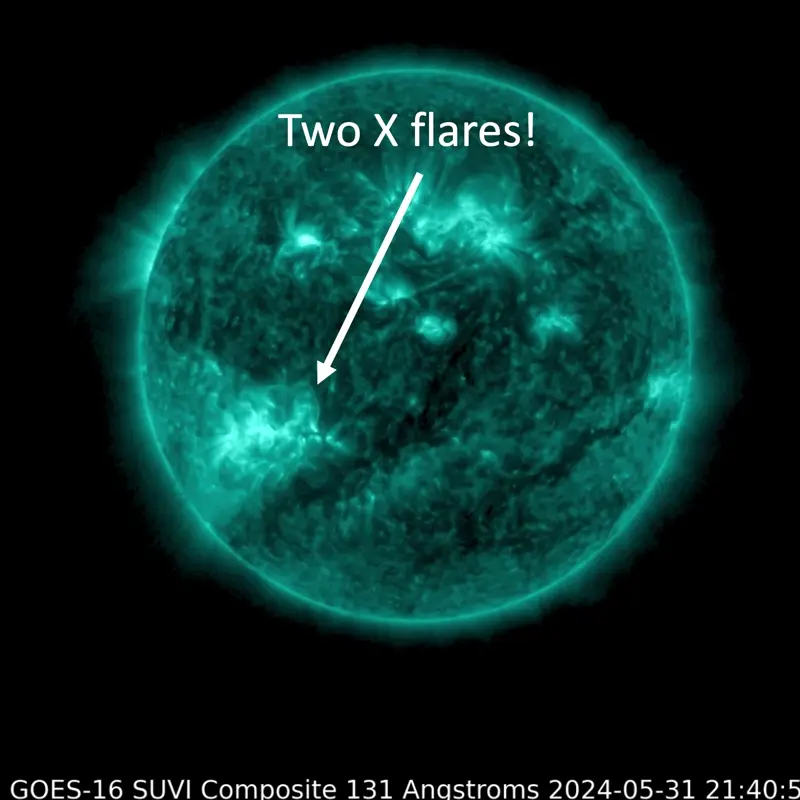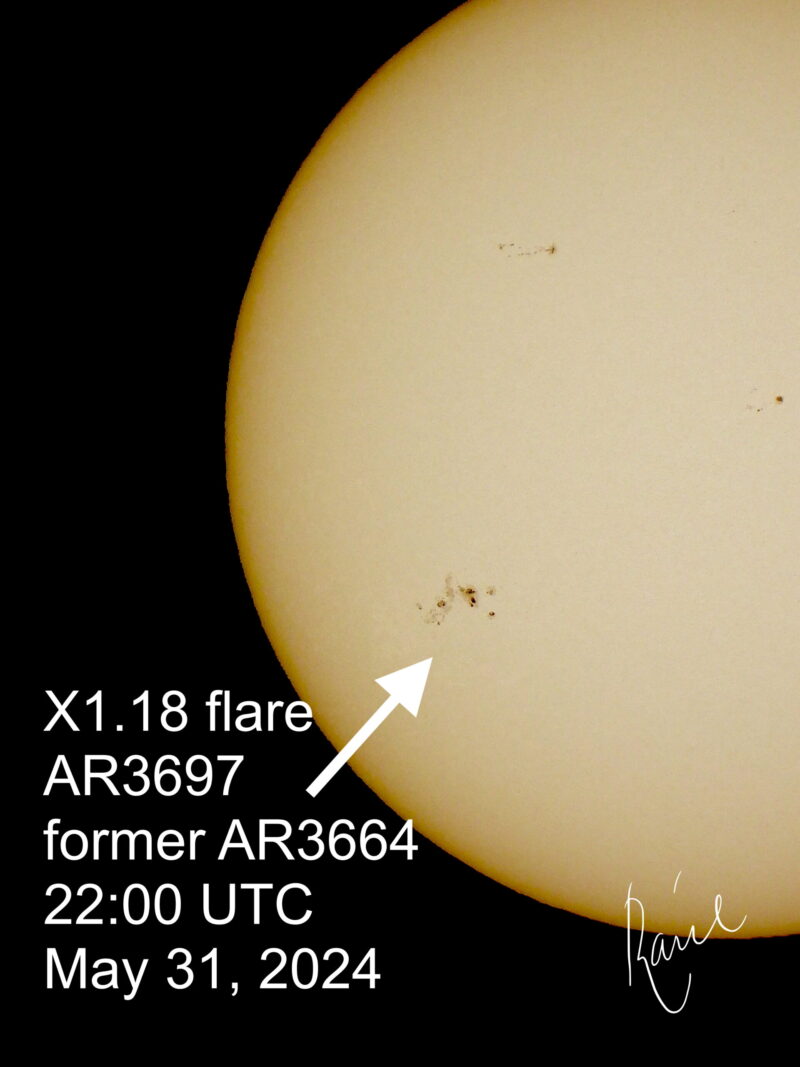Sun news June 30, 2024: Parker Solar Probe nearly touches sun today
Today’s top story: Today, NASA’s Parker Solar Probe enters its 2nd-to-last perihelion (closest approach to sun). It’ll sweep within 5.3 million miles of the sun this time, bringing it ever-closer to its final historic closest approach of less than 4 million miles from the sun, due in December 2024. At that final perihelion, NASA has said, Parker Solar Probe will “touch” the sun. Perihelion is the point of closest approach when orbiting the sun. Parker has made incremental steps during its mission to get closer and closer during its perihelion. It has 26 planned perihelions. After each Venus flyby, the spacecraft makes it slightly closer in its orbit of the sun. Subsequent perihelions are at the same distance until the next Venus flyby brings the craft closer. Parker has made six Venus flybys. Its June 30 and September 30 perihelions mark the last orbits around the sun before it makes its seventh and final Venus flyby on November 6, 2024. Then, on December 24, 2024, the Parker Solar Probe reaches its closest perihelion, when it will be around 3.9 million miles (6.28 million km) from the sun’s surface (the photosphere), traveling at nearly 500,000 mph (800,000 kph). The spacecraft has long since surpassed the records for closest approach to the sun and fastest human-made object. This record will probably stand firm for years – maybe decades – or even longer. The mission was first dreamed up in 1958, when Eugene Parker predicted the existence of the solar wind. It was not until August 2018, 60 years later, that this dream could finally be achieved. This mission’s ultimate goal post is another six months away, but over the past six years the mission’s data has fundamentally changed our understanding of the sun, its interaction with the solar system, space weather, and other stars in the universe. There is much data to still explore but many fundamental discoveries have already been made. Here are just a few:
- Solar wind origins: One of the most fundamental science goals is understanding the solar wind. So of the puzzles answered or created these can be listed out in more detail.
- Coronal heating: Data supporting the theory that magnetic waves and small-scale magnetic reconnection events significantly contribute to the corona’s high temperatures.
- Temperature profiles: Temperature measurements of different solar wind components improve our understanding of heating mechanisms.
- Solar wind speed variations: Observations show that the solar wind’s speed increases dramatically closer to the sun.
- Solar wind composition: The solar wind’s elemental and isotopic composition reveals new information about the sun’s outer layers.
- Shock waves in solar wind: Shock waves within the solar wind provide insights into their formation and impact on space weather.
- Plasma wave observations: Various plasma waves in the solar wind have been identified, helping to explain energy transfer processes.
- Magnetic switchbacks: Unraveling the origins of mysterious zigzagging magnetic structures in the solar wind.
- Dust-free zone: Finding a potential dust-free zone around the sun, where intense radiation vaporizes dust particles.
- Particle acceleration: Insights into how solar energetic particles are accelerated and transported.
- Alfvén critical surface: Direct measurements of the boundary where the solar wind transitions from magnetic to plasma dynamics by crossing the Alfvén critical surface. This is the transition between the sun and interplanetary space where Parker “touched the sun.”
- Coronal mass ejections (CMEs): Data on the properties and propagation of CMEs help improve space weather forecasting.
- Solar magnetic field structure: Mapping of the sun’s magnetic field structure provides unprecedented insights into its complex magnetic environment.
- Solar corona dynamics: Provide observations of dynamic phenomena in the solar corona, including magnetic reconnection events and wave-particle interactions.
- Magnetic fields and solar activity: Detailed observations of magnetic field lines and their interactions contribute to our understanding of solar flares and coronal mass ejections and space weather.
- Venus’ atmosphere and surface: The first ever visible light images of Venus’ surface made through the atmosphere along with new radio observations of the planet.
Last 24 hours: Sun activity remained at low levels over the past 24 hours. The sun produced nine C flares during our observation period (between 11 UTC yesterday and 11 UTC today). The largest event was a C5.9 flare from AR3734 at 15:32 UTC on June 29. Three new regions were numbered: AR3733, AR3734, and AR3735. The sun has 15 numbered active regions on its Earth-facing side. All regions have simple magnetic complexity configurations of either alpha or beta. A filament erupted from the southwest on June 29 at 16:00 UTC. It produced a coronal mass ejection (CME) toward the SW and is expected to glance Earth on July 3.
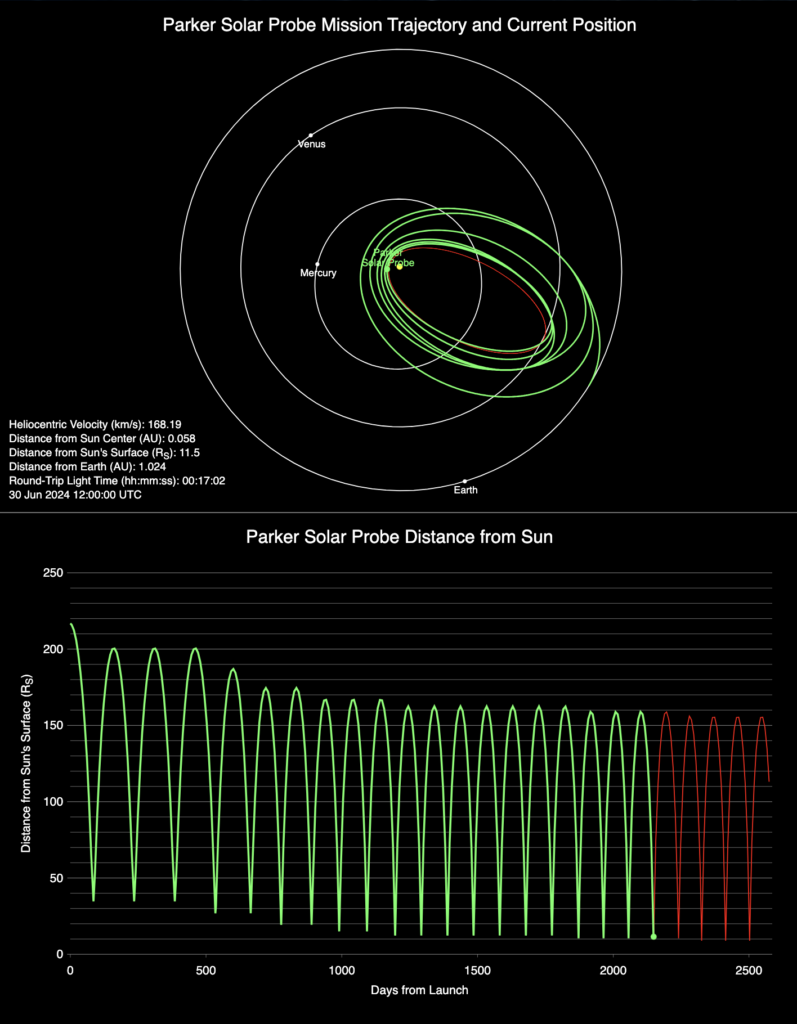

Sun news June 29, 2024: Unexpected severe storm brings aurora
Last night, the northern lights lit up the sky over Chantry Island while casting vibrant reflections onto Lake Huron from sunset to sunrise in Southampton, Ontario, Canada. #northernlights #onwx #auroraborealis pic.twitter.com/3yhpb1mbfH
— Scott Rock (@scottrockphoto) June 28, 2024
The coronal mass ejection (CME) that the sun hurled into space on June 25 surprised us with an earlier arrival than anticipated. Earth’s magnetic field reached a G4 (severe) geomagnetic storm level yesterday. The original forecast was for a G1 (minor) geomagnetic storm late yesterday, but shortly after 11 UTC on June 28 (just after this post), the geomagnetic level reached a G1 level before climbing to G4. We hit the G4 threshold at 14:15 UTC yesterday, which lasted for a three-hour period. It then dropped to a G1 level for the next six hours. The surprise severe geomagnetic storm hit during daylight hours in Europe, the U.S. and Canada, but auroral displays were surely possible in the Southern Hemisphere. Did you see the auroras and take photos? Share them with us here.
Last 24 hours: Sun activity stayed at low levels over the past 24 hours. The sun produced fewer flares and only C flares during our observation period (between 11 UTC yesterday and 11 UTC today). The sun produced three flares. The largest was a C3.2 flare – by an as-yet-unnumbered active region – at 14:40 UTC on June 28. Active region AR3723 split into two different active regions due to its extended magnetic structure. The newly separated region is now labeled AR3730. With this separation, we are seeing the end of that large, now-historic active region producer of the largest X8.8 flare of Solar Cycle 25. After following the sun for weeks, we believe AR3723 is the present incarnation of the former AR3664. The sun has 12 numbered active regions on its Earth-facing side. There are three newcomers on the solar disk today: AR3730, AR3731 and AR3732. All the sunspot regions have simple alpha or beta magnetic configurations. Most solar activity continues around the solar limb (edge) in the form of prominences.
Aurora, lightning, Milky Way, and a giant meteor. This is not a composite or AI. This was real life in South Dakota last night! #SDwx pic.twitter.com/SL18et62nw
— Aaron Rigsby (@AaronRigsbyOSC) June 28, 2024
I did position to film sprites from western South Dakota as an MCS moved east near sunset yesterday. I did NOT expect to have #aurora show up in the background. A huge bucket list item for me. This sprite even had a green ghost. @PaulMSmithphoto @xWxClub @StormHour pic.twitter.com/Hmuwjxyx4D
— Tom A. Warner (@ztresearch) June 28, 2024
Sun news June 28, 2024: Auroras possible tonight
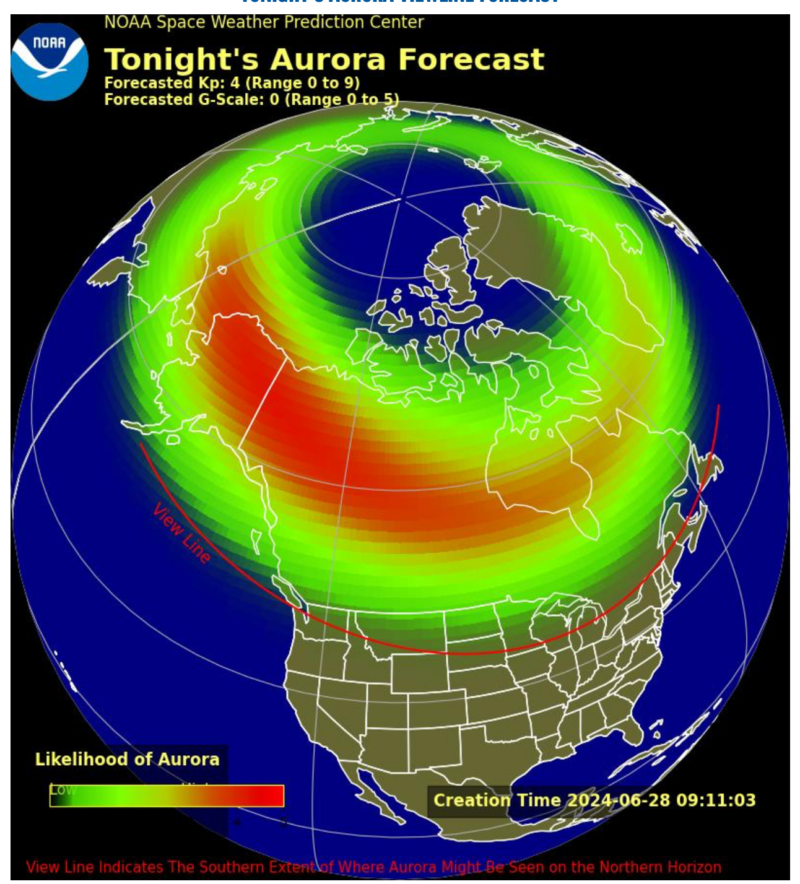
Aurora watchers, get ready! Auroral displays are possible tonight with the arrival and glancing blow of a huge blob of plasma and magnetic fields — a coronal mass ejection or CME — that left the sun on June 24. At the time of this writing, Earth’s geomagnetic field is active. A G1 (minor) geomagnetic storm is anticipated later today. That could mean auroral displays for those in far northern latitudes. Good luck, aurora-chasers! Get those cameras out, and be sure to send us your beautiful photos.
Last 24 hours: Sun activity remains low with only C flares produced over the past day. Solar flare production during our observation period (between 11 UTC yesterday and 11 UTC today) consisted of 13 C flares. The largest event was a C6.6 flare at 23:47 UTC on June 27 from sunspot region AR3730. AR3730 is a newly labeled region that came after AR3723 became extended and was split in two. AR3723 remains lead flare producer with four C flares. The sun has nine numbered active regions on its Earth-faced side. All the sunspot regions have simple alpha or beta magnetic configurations. Most sun activity remains around the solar limb (edge) in the form of prominences.
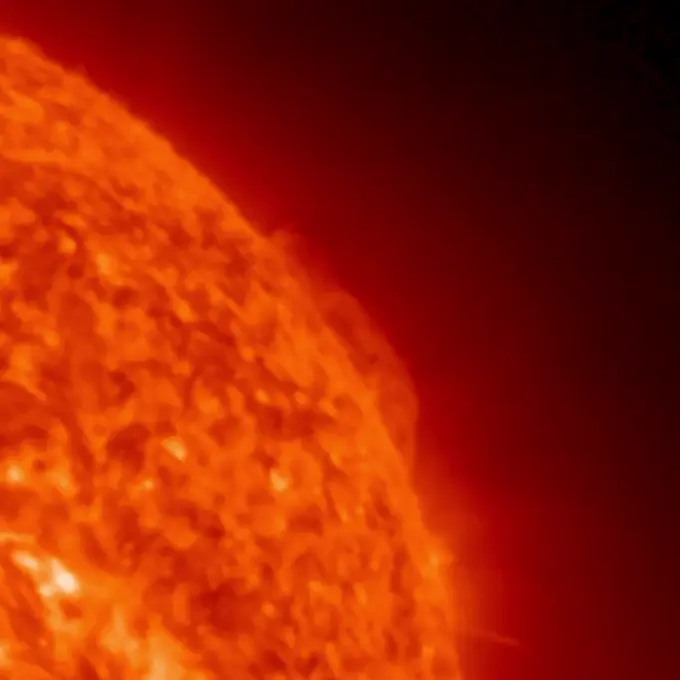
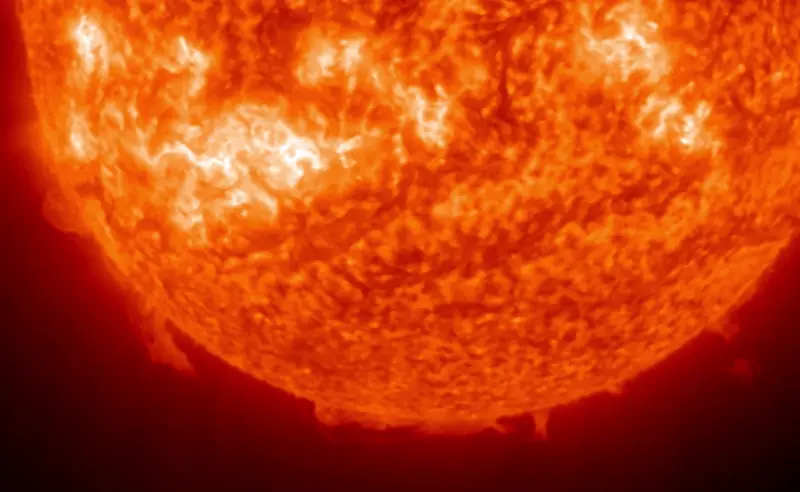
Sun News June 27, 2024: Sun-stuff incoming, auroras on the way?
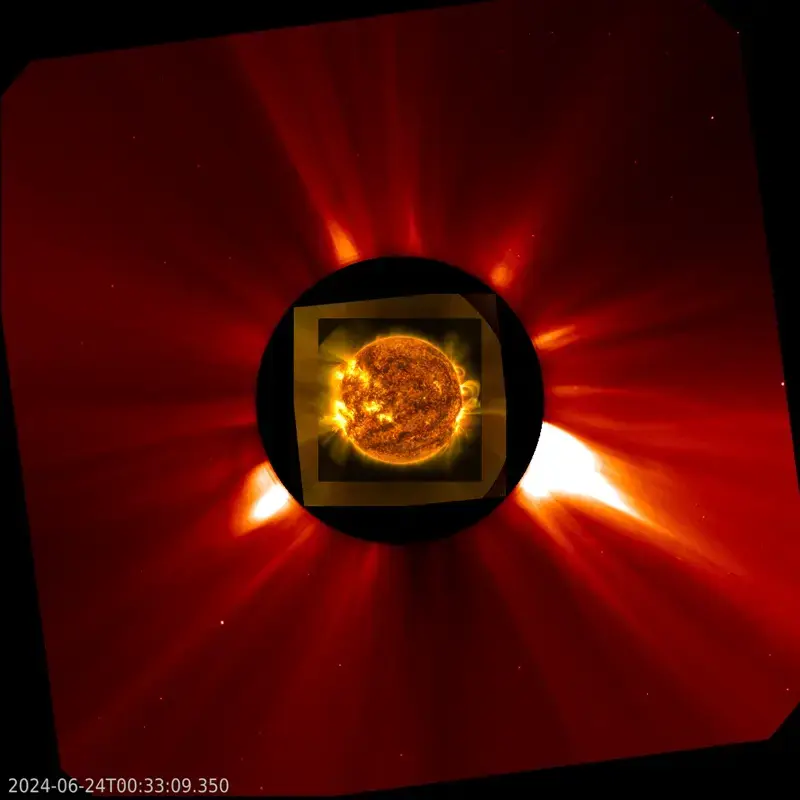
A huge blob of plasma and magnetic fields – a coronal mass ejection, or CME – is currently on its way to Earth. It was hurled by the sun on June 24, and its anticipated glancing blow in the next 24 hours could trigger a G1 (minor) geomagnetic storm tomorrow. That could mean auroral displays for those in far northern latitudes. Good luck, aurora-chasers!
Last 24 hours: Solar activity has dropped to low after only C flares were fired over the past day. The sun produced 13 C flares between 11 UTC yesterday and 11 UTC today. The largest event was a C6.3 flare at 15:30 UTC on June 26 from sunspot region AR3728 in the southeast. The lead flare producer of the period was AR3723, which produced four C flares. Most activity was around the sun’s limb (edge), where we saw many jets and prominences. AR3713 kept its high-potential beta-gamma-delta magnetic complexity. The rest of the nine labeled sunspots on the solar disk are showing simple alpha or beta configurations. There’s a newcomer region on the Earth-facing side of the sun labeled AR3729.
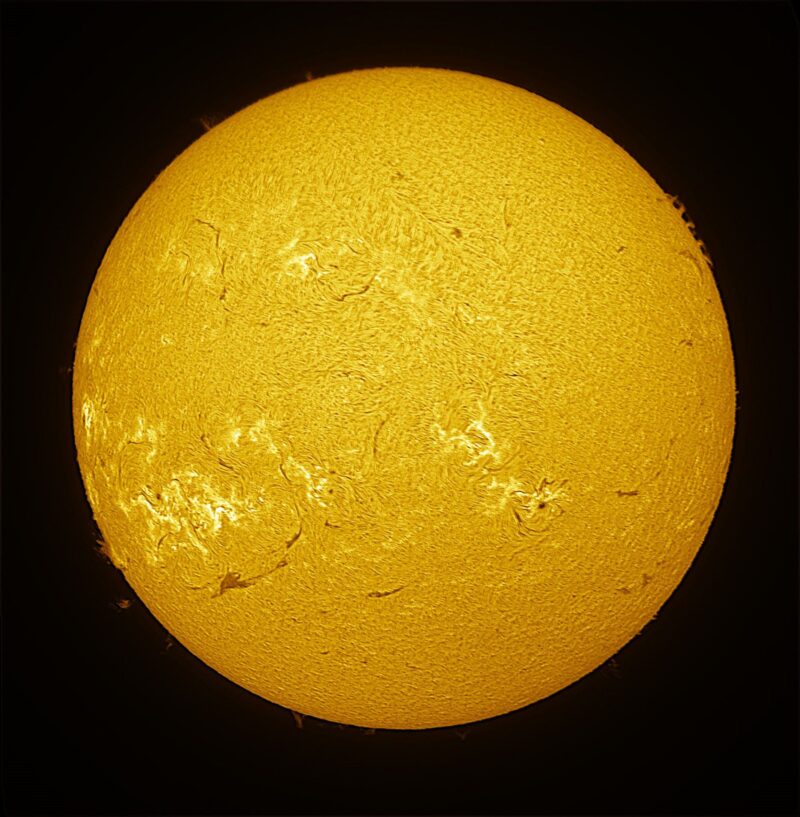
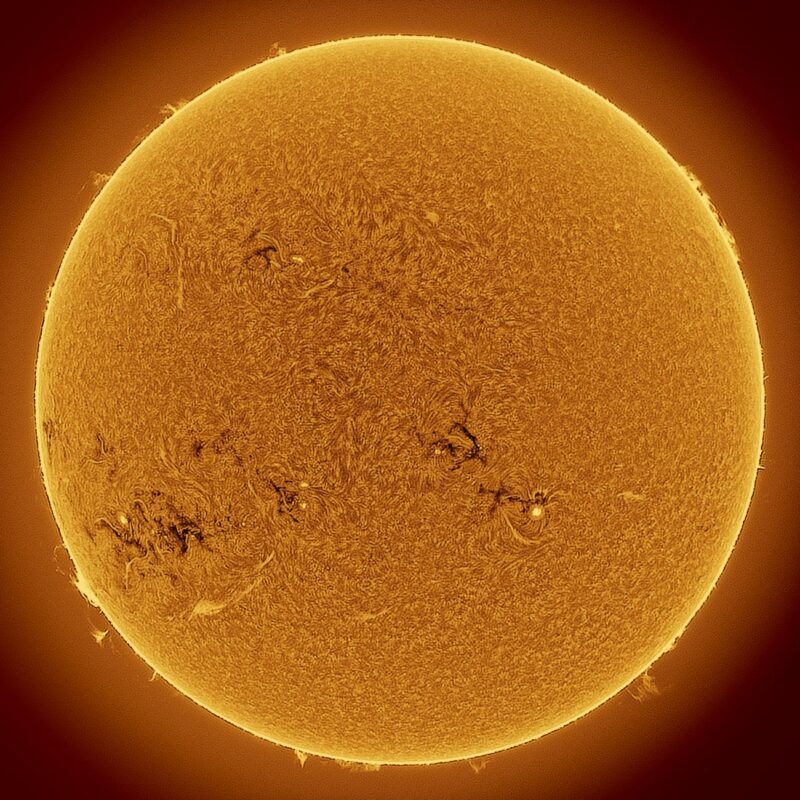
Sun News June 26, 2024: GOES-U goes up!
View this post on Instagram
Following some nail-biting over the weather, GOES-U, the 4th and final member of NOAA’s GOES-R series of Earth- and spaceweather-observing craft, lifted off successfully yesterday from NASA’s Kennedy Space Center (KSC) in Florida. A SpaceX Falcon Heavy rocket boosted the satellite to a geosynchronous transfer orbit. That Falcon Heavy consisted of three modified, strapped-together first stages, by the way, with a second stage and the payload, sitting atop a central booster. About eight minutes after liftoff, the two side boosters returned to Cape Canaveral Space Force Station, next door to KSC, touching down almost side by side. Mind-blowing sight! See it in the Instagram post above from Greg Diesel-Walck and Chrissy Walck of the EarthSky community! The Geostationary Operational Environmental Satellites-U (GOES-U) is special in a couple of ways. It is the last of the GOES-R line. That will be replaced by the GOES extended line. The satellite is designed to provide critical data on earthly weather and climate – plus solar data – to meteorologists and other parties. Near-Earth spaceweather will be monitored. NOAA GOES provides an outstanding service in spaceweather and so much more. See our interview with NOAA spaceweather forecaster Shawn Dahl on NOAA’s warning system for solar flares with respect to earthly power grids, satellites and aviation. Congrats to NOAA on the launch, and, to everyone else, stay tuned!
Last 24 hours: An isolated M flare kept solar activity at moderate levels. The blast was a faint M1.0 by newcomer active region AR3727 in the southeast. It occurred at 12:45 UTC on June 25. Shortly after the flare, an R1 (minor) radio blackout affected an area over Morocco. Sun activity during our observation period (11 UTC yesterday to 11 UTC today) has been mostly faint C flares. The sun produced a total of 20 flares; 19 Cs plus the abovementioned M flare. Activity was seen mostly around the sun’s periphery, with many jets and long-lasting prominences. Only active region AR3713 has an interesting magnetic configuration, a beta-gamma-delta complexity. The rest of the labeled sunspots on the solar disk show alphas or betas (the more complex the magnetic configuration, the greater the chance for flares). The sun now has eight active regions on its Earth-facing side. There are two newcomers on the Earth-facing side of our sun, now numbered AR3727 and AR3728. Newcomer AR3727 is the lead flare producer of the period, it blasted out seven flares, the only M flare of the day plus another six Cs.
Sun news for June 25, 2024: Filaments erupting across sun’s face today
We often focus on flares when talking about sun activity. They’re flashy, no doubt. But today filaments are erupting across the sun’s visible face. These are great ropes of solar material and magnetic fields arcing up from the visible surface of the sun. We see them in a range of sizes today. Some of the largest filaments extend across the entire solar disk, meaning they are more than half a million miles (800,000 km) long! A huge filament in the sun’s southeastern quadrant unraveled from the sun, releasing billions of tons of stuff into space at millions of miles an hour. Another erupted off the western limb from farther around the limb (edge). Like flares, filaments can produce a strong magnetic impact at Earth. Some of the most impactful events are actually a combination of a flare and an erupting filament. The sun is amazing and exciting to watch. Stay tuned.
Last 24 hours: After yesterday’s almost-X flare (a flashy introduction to returning sunspot region AR3723), sun activity has calmed to moderate levels. AR3723 is probably the historic region that we’ve seen go twice across the sun’s visible face already, albeit with different labels (AR3697 and AR3664). In one of those former incarnations, it produced the biggest X flare of Solar Cycle 25 so far. Will this region continue to produce historic activity? We don’t know, but the region is worth watching. Meanwhile, we had M flares during the past day (11 UTC yesterday to 11 UTC today), so that sun activity has dropped from yesterday’s high to moderate today. There were 11 flares in the past day, three Ms plus eight C flares. The largest was an M1.5 flare from active region AR3713 at 11:48 UTC on June 5. Shortly after the flare, an R1 (minor) radio blackout affected an area over Algeria. The breakdown of the M flares is:
– M1.1 flare by AR3720 at 11:13 UTC on June 24. R1 (minor) radio blackout over Algeria.
– M1.5 flare by AR3713 at 11:48 UTC on June 24. R1 (minor) radio blackout over Algeria.
– M1.1 flare by AR3713 at 19:10 UTC on June 24. R1 (minor) radio blackout over the Bahamas.
Departing active region AR3713 has a beta-gamma magnetic configuration, as does sunspot region AR3720. After its flashy entrance, yesterday’s producer of an almost X flare, active region AR3723, is showing a beta-gamma-delta complexity. This is a good indication that it has the potential for more interesting activity. The sun has seven active regions on its Earth-facing side today.
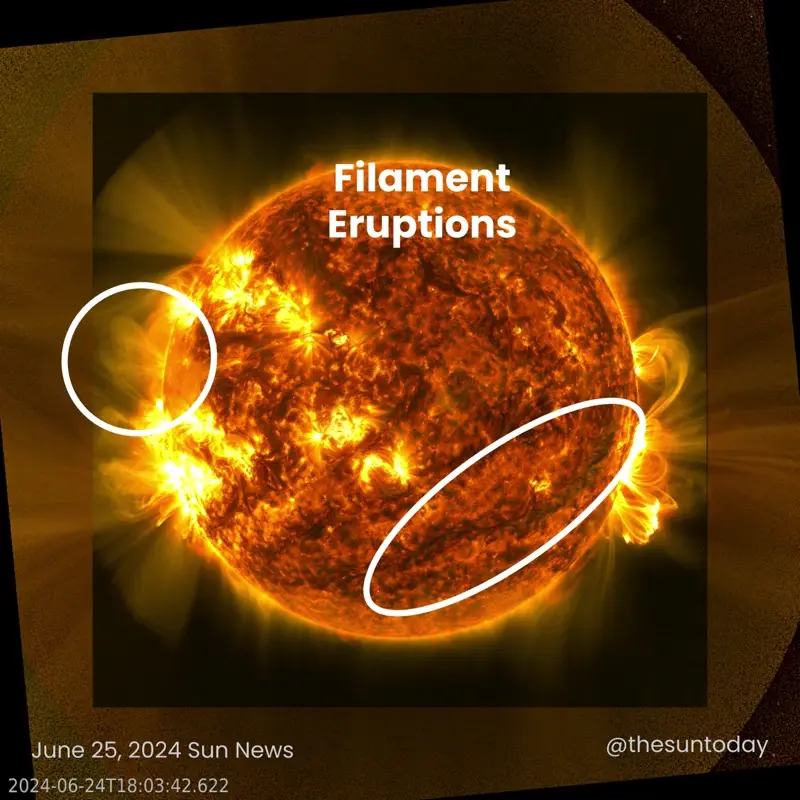
Sun news for June 24, 2024: Super sunspot returns with almost-X flare
The super-sunspot region is back! This will be its third trip across the sun’s visible face. This is the same region that produced the largest X flare of Solar Cycle 25 so far. And this region was one of the major drivers of the great solar superstorm of May 2024. It’s now labeled AR3723, formerly AR3697, formerly AR3664. Over the past day, sun activity reached high levels thanks to a near-X flare (an M9.3) from this returning region, plus three more M flares. The region has not come fully into view, but from an initial look, it does not appear to be as large this third time around. But it’s still carrying a magnetic punch! And that means a potential for more flaring. The other three M flares came from departing region AR3712, which has been one of the major flare producers over the past two weeks. The first two M flares were isolated and the last two were associated with a larger eruption from AR3712. The eruption was largely west-directed. Now we wait to see what AR3723 has in store. Stay tuned!
Last 24 hours: Sun activity reached high levels with the release of the near-X M9.3 flare from the newly labeled region AR3723. Departing region AR3712 produced the other three M flares during our observation period (11 UTC yesterday to 11 UTC today). The sun produced 15 flares over 24 hours, 11 C flares and four M flares.The largest event of the period was the M9.3 flare at 12:51 UTC on June 23 from AR3723. The last two M flares from AR3712 were part of a larger eruption of the western limb. The M9.3 flare caused an R1 (minor) radio blackout over the eastern Atlantic Ocean and western Africa. The other three M flares caused R1 radio blackouts where the sun was highest in the sky.
This list of M flares is:
– June 23 11:26 M1.3 AR3712, R1 radio blackout over the E. Atlantic Ocean and W. Africa
– June 23 12:51 M9.3 AR3723, R3 radio blackout over the E. Atlantic Ocean and W. Africa
– June 24 04:08 M1.3 AR3712, R1 radio blackout over Asia
– June 24 04:45 M1.9 AR3712, R1 radio blackout over Asia
Regions AR3712, AR3713, and AR3719 have beta-gamma magnetic complexity, and AR3725 has beta-delta complexity. There are three new regions: AR3724, AR3725, and AR3726. The sun has 10 active regions on the Earth-facing disk.
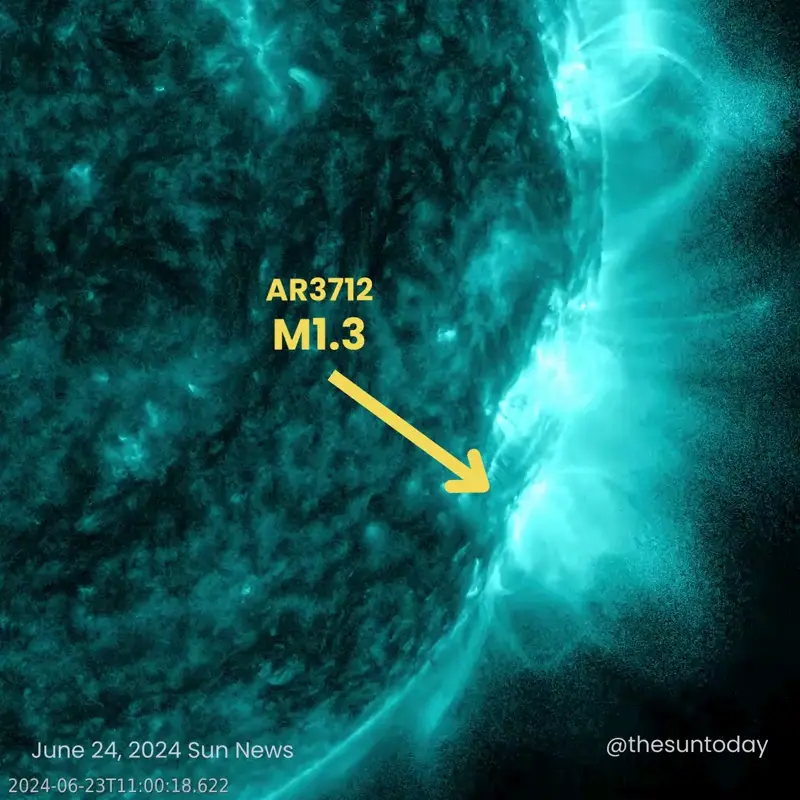
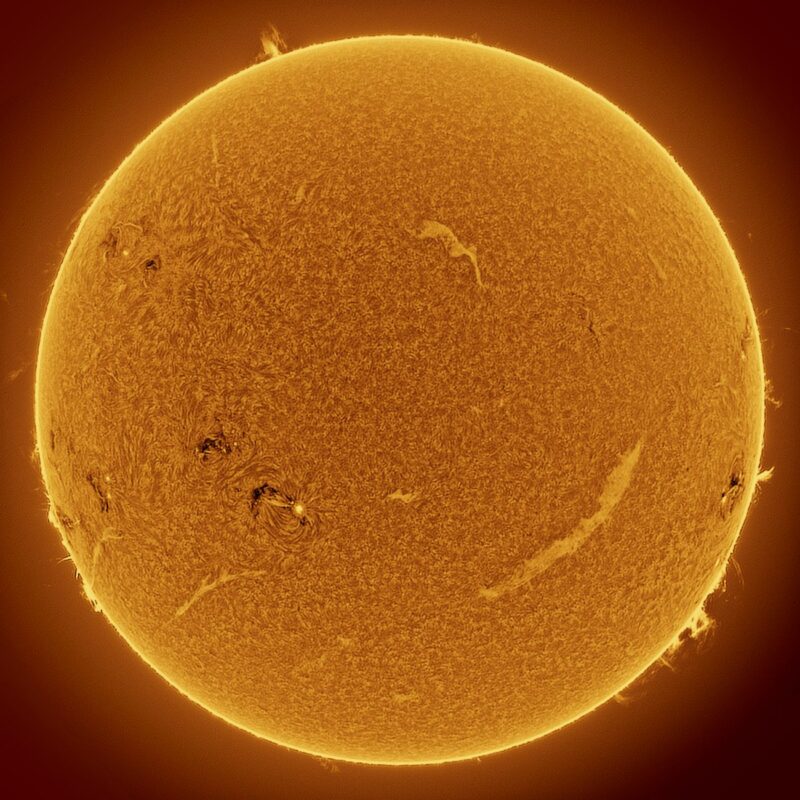
Sun news for June 23, 2024: Is energetic region AR3697 back?
Could energetic sunspot region AR3697 be back? Around 3:18 UTC on June 23, a filament erupted off the sun’s southeastern limb, the side just now rotating into view. Thanks to helioseismology, we know this filament eruption might be associated with a known sunspot region. It could be sunspot region AR3697, formerly AR3664, now perhaps making its 3rd trip across the sun’s visible face (after being carried out of view twice by the sun’s rotation). This sunspot region produced some of the strongest activity of Solar Cycle 25 so far. It was a major driver of the May, 2024, superstorm. Stay tuned to see if this region brings us more excitement in its new incarnation.
Last 24 hours: Isolated M flares, one at the beginning of our observation period (11 UTC yesterday to 11 UTC today) and one near the end, kept sun activity levels at moderate. We saw 19 flares in all over the past day. We also saw an eruption off the sun’s northwest this morning, at 6:18 UTC, as an expansion of a coronal loop. The first M flare (in the east from AR3720) was an M1.0 flare at 11:00 UTC on June 22. It caused an R1 (minor) radio blackout over Africa. The second M of the day, the largest of the period, was an M2.4 flare blasted out by active region AR3716 at 6:16 UTC on June 23. It caused an R1 (minor) radio blackout over Asia. AR3712 and AR3720 were the lead flare producers during the observation period. Sunspot region AR3713 kept its delta magnetic complexity, while AR3712 and AR3716 now show a beta-gamma configuration. These three flares have flare potential. As they get closer to the west limb (edge), any solar energetic particles resulting from those flares might travel a special avenue toward Earth, known as the Parker Spiral. The sun has seven active regions on the Earth-facing disk.
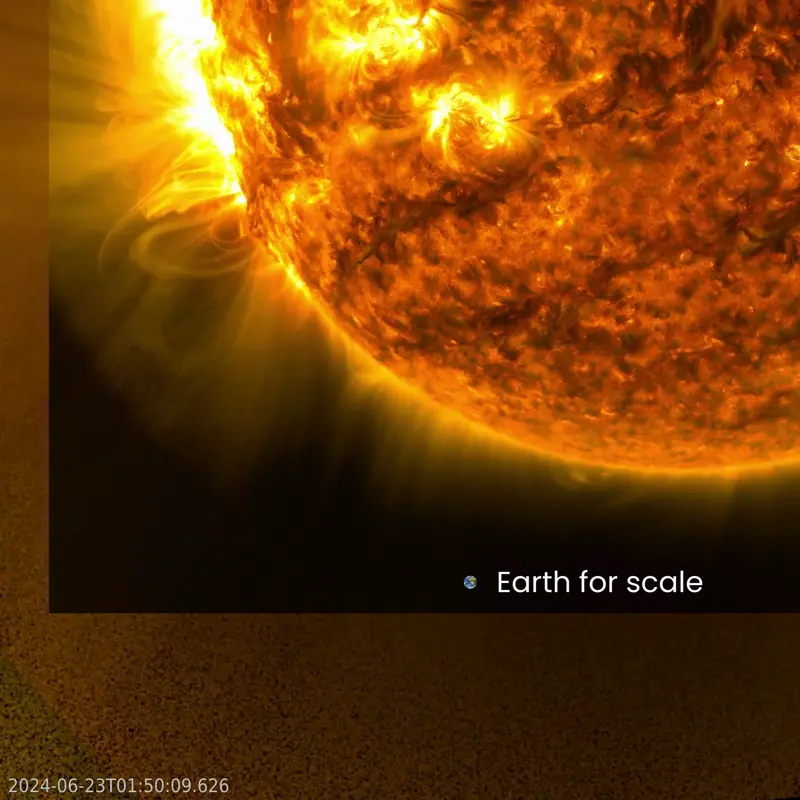
Sun news for June 22, 2024: Huge filament eruption
A huge filament eruption in our sun’s southeast – along with 2 M flares – broke the relative calm of the past day. The filament eruption was a gorgeous blast, hurtling a billion tons of sun-stuff off into space. It was associated with a C6.7 flare, a relatively small flare, occurring in the vicinity of a new, as-yet-unnumbered sunspot region. The event happened at 23:50 UTC on June 21. The resulting coronal mass ejection (CME) is under analysis. But, given the position on the sun’s disk of the source of the eruption, this CME more than likely does not have an Earth-directed component.
Last 24 hours: After a long list of C flares over our past day’s observation period (11 UTC yesterday to 11 UTC today), a couple of M flares brought sun activity to moderate levels. Overall flaring production was of 20 blasts, including the mentioned two Ms. The first M flare of the period was an M1.3 flare by an incoming unnumbered yet active region in the southeast at 4:38 UTC on June 22. An R1 (minor) radio blackout was observed affecting an area over Guangdong in China. The second M of the day, the largest of the period, was an M2.9 flare blasted out by active region AR3716 at 8:55 UTC on June 22. A correspondent R1 (minor) radio blackout was registered over Arabian Peninsula. Between 11 UTC yesterday and 11 UTC today, lead flare producer honors were shared by three active regions: this as-yet-unnumbered region now coming into the southwest, AR3713 and AR3716. Each blasted out four flares, with the newcomer producing one the Ms and AR3716 producing the largest M of the period. The sun has eight numbered active regions on its Earth-facing side today. There are two other numbered newcomers on the solar disk, AR3721 and AR3722. Sunspot region AR3713 keeps its delta magnetic complexity, while AR3712 and AR3716 show a beta-gamma configuration. So the three of them have flare potential. And they’re getting closer to the west limb (edge), coming to a place on the sun where – if they do produce strong flares – any solar energetic particles resulting from those flares might travel a special avenue toward Earth, known as the Parker Spiral.
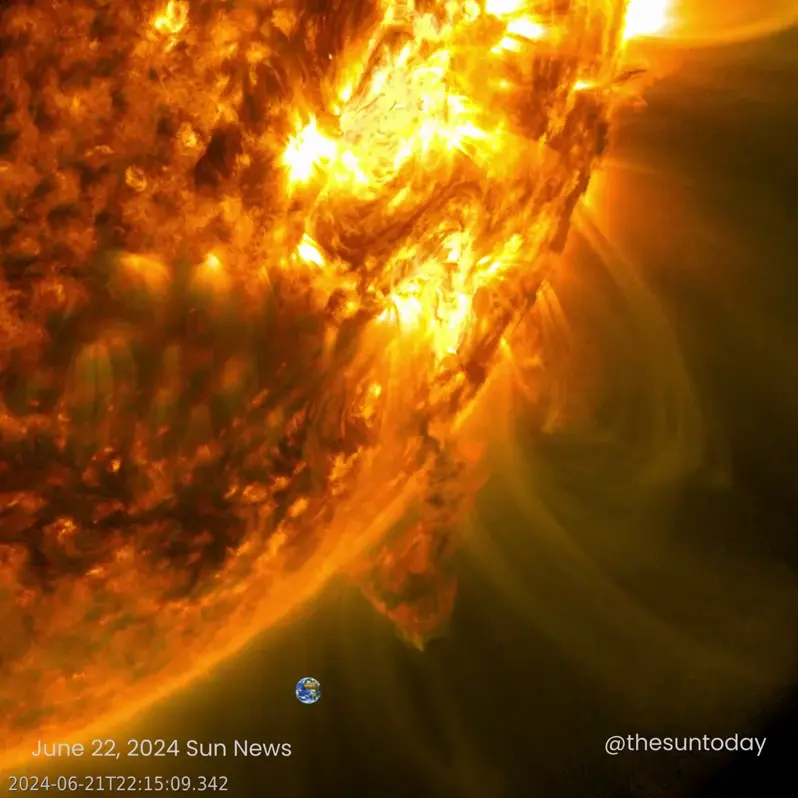

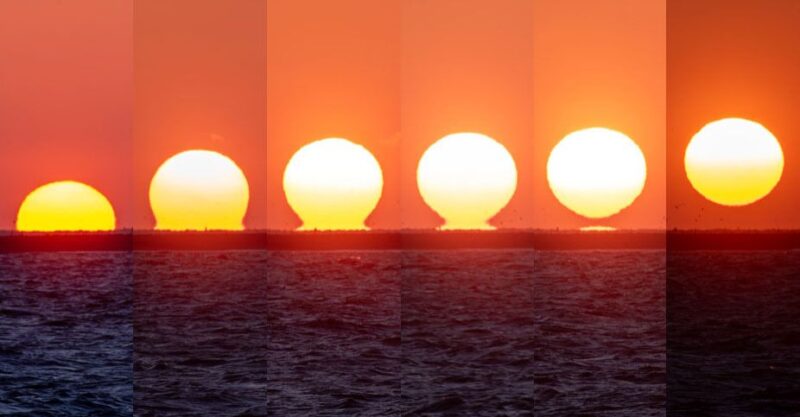
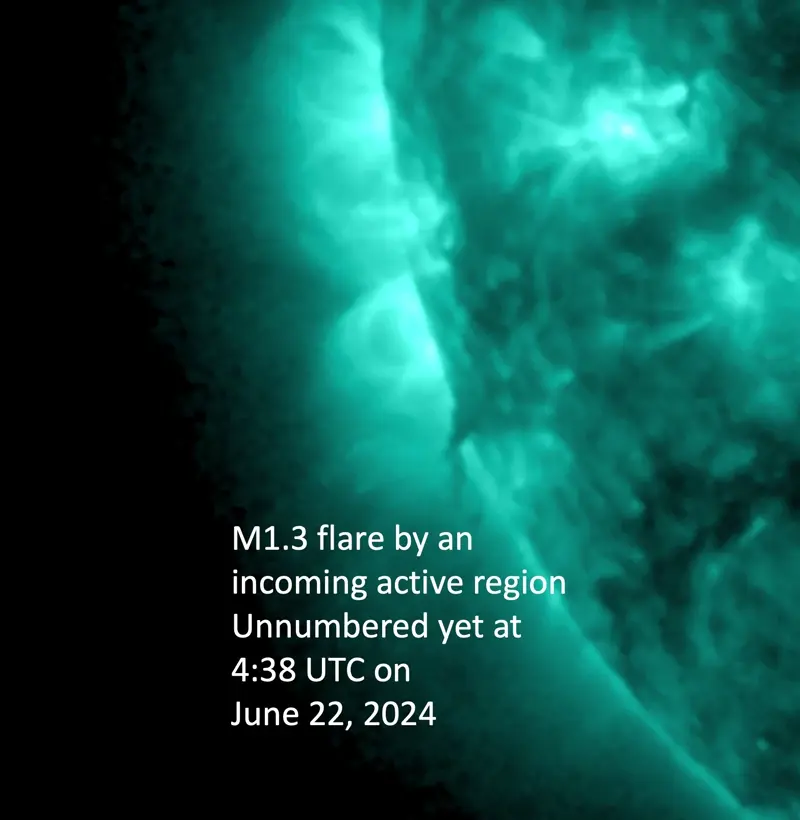
Sun news for June 21, 2024: High activity from an unexpected region
Sun activity has risen to high levels thanks to an impulsive M5.8 flare. Impulsive means short with no material eruption. This came unexpectedly from a newcomer sunspot region in the sun’s southeast quadrant, labeled AR3719. The flash occurred at 23:16 UTC on June 20, causing an R2 (moderate) radio blackout affecting an area over the Pacific Ocean off the west coast of Hawaii. We have often said that the sun continues to surprise us. This flare is another example! Given their magnetic complexity, regions such as AR3712 might have been expected to flare. But, seemingly out of nowhere, AR3719 in the southeast released its impulsive flare. As we continue our journey through solar maximum – the peak of the 11-year sunspot cycle, happening now – we should expect more surprises. As the Mexican proverb says, “The hare jumps from the most unexpected place.”
Last 24 hours: An M5.8 flare during our observation period in the past day, brought sun activity to high levels. The overall flaring number also increased. Between 11 UTC yesterday and 11 UTC today, the sun produced 18 flares, two M flares and 16 C flares. The first M flare of the period was an M1.1 flare from AR3719 at 15:18 UTC on June 20. The flare caused an R1 (minor) radio blackout, affecting an area over the Atlantic Ocean. The second M, the largest of the period, was an M5.8 flare from AR3719 at 23:16 UTC on June 20. An R2 (moderate) radio blackout affected an area over the Pacific Ocean off the west coast of Hawaii. The lead flare producer of the day was active region AR3716, which produced five C flares. The sun has six numbered active regions on its Earth-facing side. AR3712 lost its delta magnetic complexity, now showing a beta-gamma configuration, but AR3713 gained a delta, now with a promising beta-gamma-delta complexity. AR3716 kept its configuration. We had been expecting larger eruptions from AR3712 or some of the other regions in the west, but as often happens, the sun surprised us. The M5.8 flare came from a newer region in the east, AR3719.
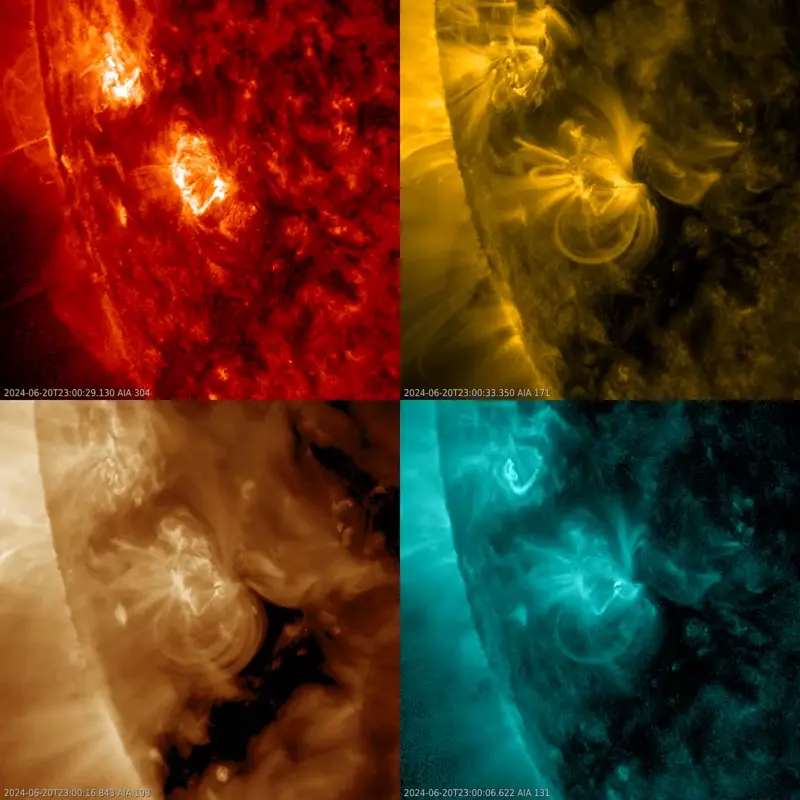
Sun news for June 20, 2024: Quiet, beautiful sun on solstice day
Happy June solstice! Today, we celebrate the change of seasons as our Northern Hemisphere is tilted most toward the sun, and the Southern Hemisphere is tilted most away. No official body has decreed it, but many on Earth will mark the beginning of a new season today, summer for the north and winter for the south. As we celebrate this day, the sun has entered a lull with no M or X flares. Most activity is focused on a beautiful filament eruption off the southwest, with filaments dancing all around the solar limb (edge). Stay tuned!
Last 24 hours: Sun activity is low. During the past 24 hours, the sun produced eight C flares. The largest event was a C6.0 flare at 1:30 UTC on June 20 from an unnumbered active region in the southwest. The lead flare producers between 11 UTC yesterday and 11 UTC today are three active regions that each produced two C flares. The regions are AR3712, AR3716, and the unnumbered active region in the southwest. The sun has six labeled active regions. There are three newcomer regions on the Earth-facing solar disk, AR3718, AR3719, and AR3720. AR3712 retained its promising beta-gamma-delta magnetic complexity, indicating a possibility for stronger flaring. And AR3713 and AR3716 are showing a beta-gamma configuration.
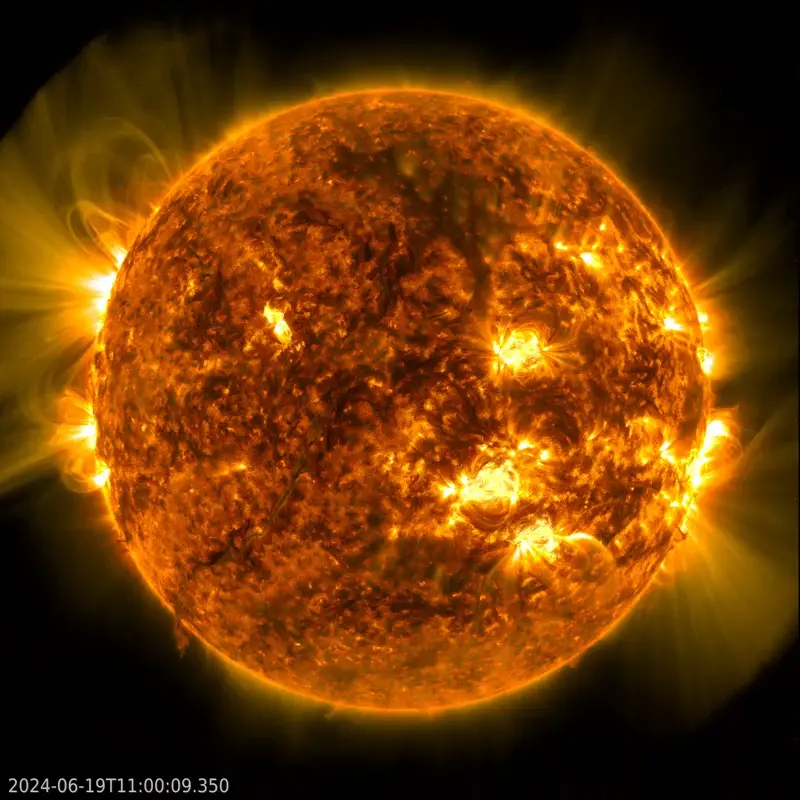
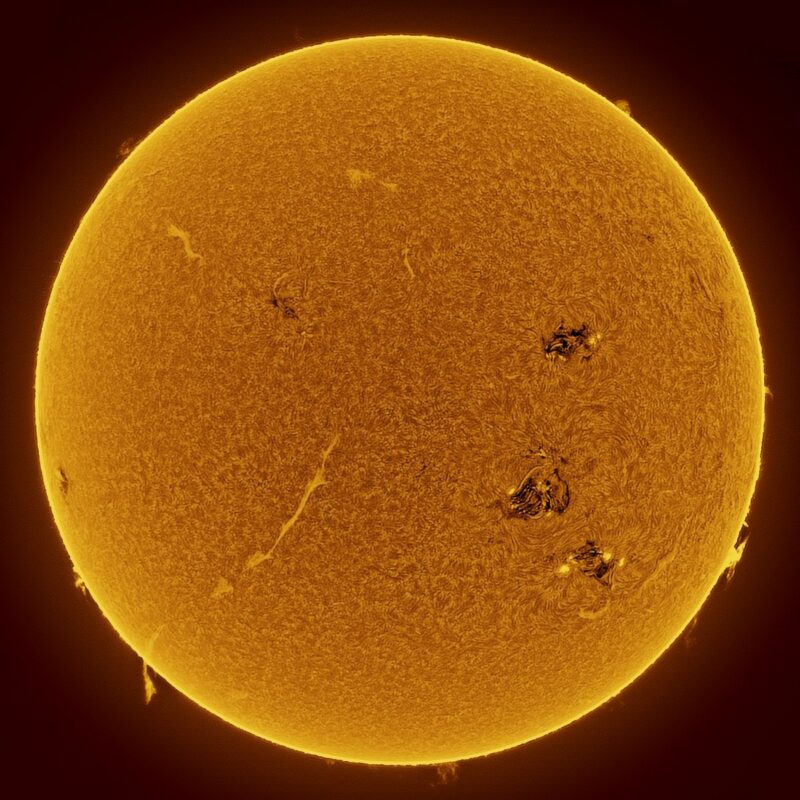
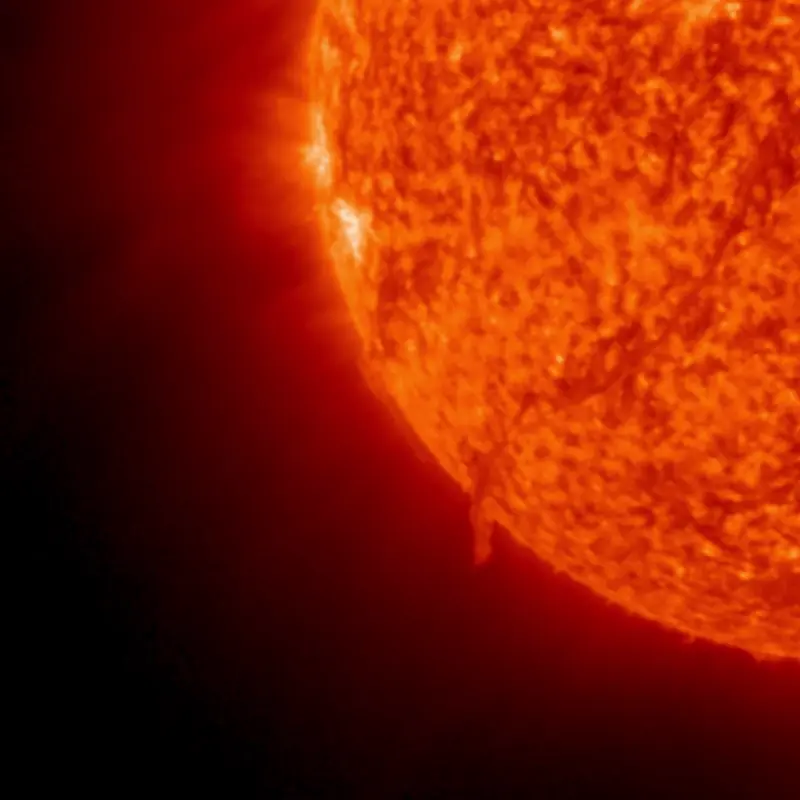
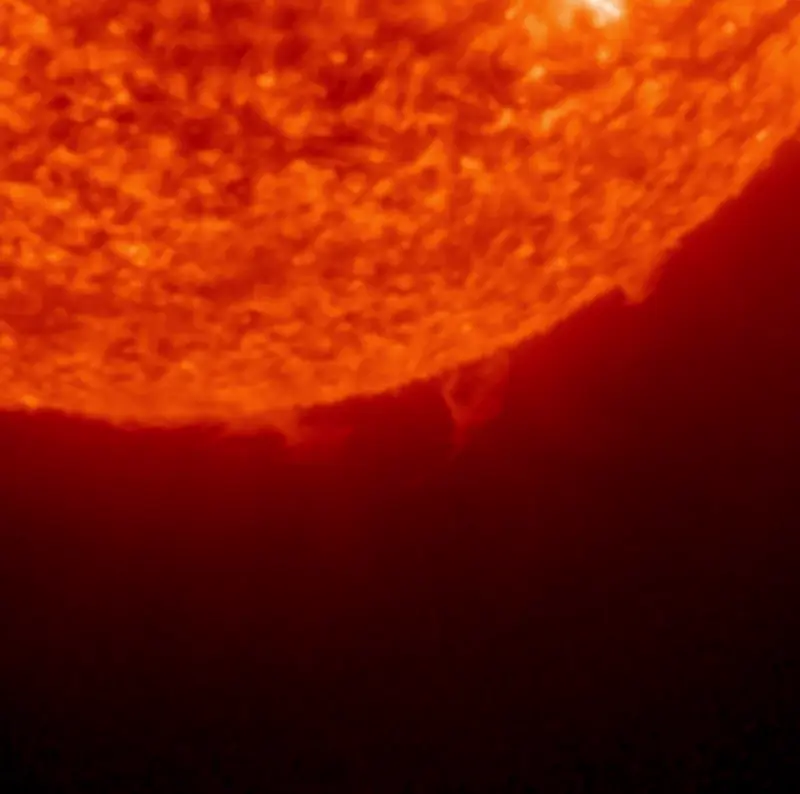
Sun news for June 19, 2024: A flurry of filament action
We said in yesterday’s update that solar excitement should be on the way, and the sun seems to have listened! Activity on our star has picked up over the past 24 hours, with three M flares adding to a whole host of breathtaking filaments and prominences. Starting around 16:30 UTC on June 18, the sun lit up with a prominence erupting over the northwest limb (edge) and near-simultaneous filament eruptions in the northwest quadrant and near sunspot region AR3711. Another filament eruption followed this in the northwest quadrant, slightly farther south. Meanwhile, large coronal loops were emerging over the eastern limb, indicating potentially large sunspot regions on the way to the Earth-facing sun. It seems that good ol’ Sol has more in store for us!
Last 24 hours: Three M flares and increased overall flare production placed sun activity at moderate. Between 11 UTC yesterday and 11 UTC today, the sun produced 15 flares: three Ms and 12 C flares. The largest event was an M2.4 flare from active region AR3712 at 11:23 UTC on June 18. Shortly after the blast, an R1 (minor) radio blackout affected an area over northeast Tunisia. The list of the three M flares is:
– M2.4 by AR3712 at 11:23 UTC on June 18. R1 (minor) radio blackout over northeast Tunisia.
– M1.2 by AR3712 at 12:20 UTC on June 18. R1 (minor) radio blackout over Morocco.
– M1.2 by AR3711 at 6:38 UTC on June 19. R1 (minor) radio blackout over northeast India and Nepal.
Active region AR3711 is departing over the southwest limb (edge), while sunspot region AR3712 remains the lead flare producer with eight flares (two Ms and six C flares) and maintains its promising beta-gamma-delta magnetic complexity. Currently, the sun has four labeled active regions on its Earth-facing side.

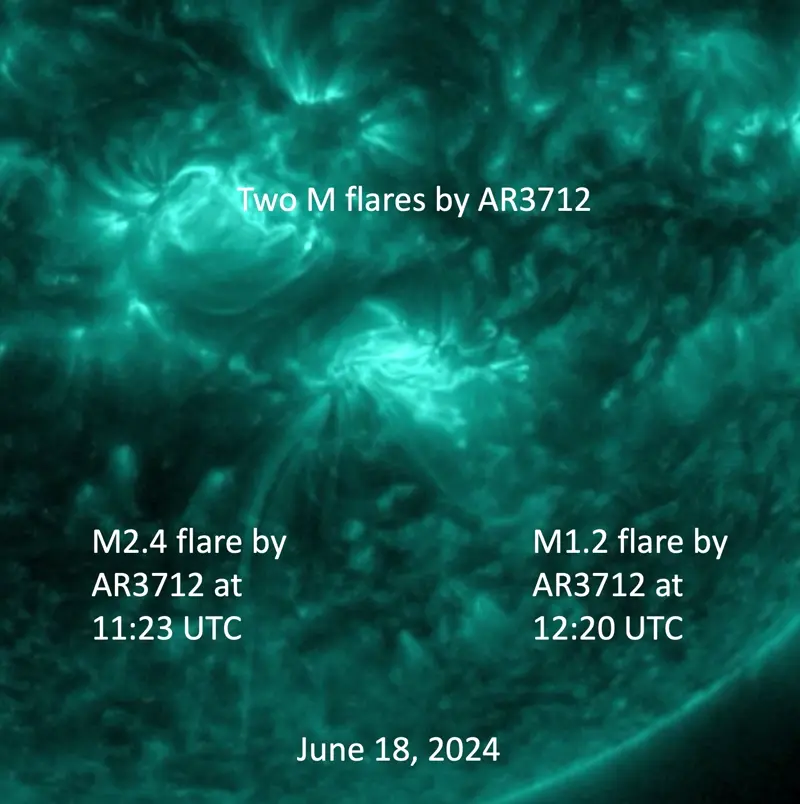
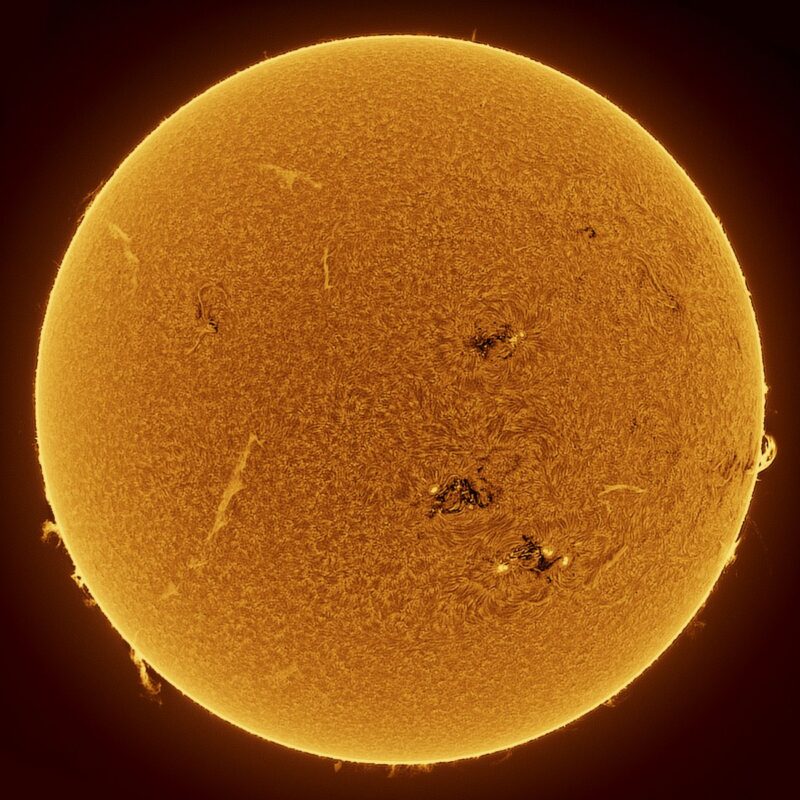

Sun news for June 18, 2024: Solar excitement anticipated
The huge sunspot region AR3712 has continued to grow in size, while maintaining its promising beta-gamma-delta magnetic complexity. This giant remains fairly gentle for now, but we’re ready for it to burst into life. Adding to the anticipation are AR3713 and AR3716, which are also showing moderate growth both in size and magnetic complexity. In addition to the regions on the Earth-facing sun, there could also be excitement waiting around the corner. The SOHO spacecraft’s LASCO instruments have detected big blasts of plasma (coronal mass ejections, or CMEs) from the far side of the sun. That means some more major sunspot regions could soon be rotating into view. Stay tuned!
Last 24 hours: Sun activity remains moderate after an isolated M flare. Between 11 UTC yesterday and 11 UTC today, the sun produced nine flares: an M and eight C flares. The largest was the M1.4 flare from active region AR3711 at 20:35 UTC on June 17. The eruption caused an R1 (minor) radio blackout that affected an area over the Pacific Ocean off the west coast of Mexico. Sunspot region AR3712 remained the lead flare producer with seven C flares. The sun has six labeled active regions on its Earth-facing side. A large coronal hole has emerged in the northeast quadrant of the Earth-facing side of the sun, while the coronal hole in the south has vanished.
Sun news for June 17, 2024: SWPC is back! 2 M flares
There was an unscheduled network outage at NOAA’s Space Weather Prediction Center (SWPC) yesterday, beginning at 8:11 UTC, June 16. Now SWPC has restored its network, allowing the world to catch up on the day’s space weather. Now we see that giant sunspot region AR3712 is picking up activity, so that, overall, sun activity has risen to moderate. The region produced two small M flares, an M1.6 and an M1.56. It increased in area by another 1.5 Earths. This brings the region up to an area equal to that of 6.5 Earths. Plus, it’s maintaining its beta-gamma-delta magnetic complexity, indicating that more M flares and possibly X flares may be on the way. A coronal hole reaching a geoeffective position could bring high speed solar wind to Earth, meaning increased geomagnetic activity in one to two days. This could bring auroras to higher latitudes. Stay tuned!
Last 24 hours: Sun activity has been moderate from 11 UTC yesterday to 11 UTC today. The sun produced 29 flares, including two M flares. The largest eruption was an M1.6 flare from active region AR3712 at 7:54 UTC on June 17. This caused an R1 (minor) radio blackout that affected an area over western Asia. The region also produced an M1.56 flare at 10:40 UTC. And that flare caused an R1 (minor) radio blackout that affected an area over Africa. Twenty-eight of the past day’s flares came from AR3712, and the remaining five C flares were from AR3709, AR3713, and AR3716. The sun has seven labeled active regions on its Earth-facing side. Two large coronal holes are on the solar disk.
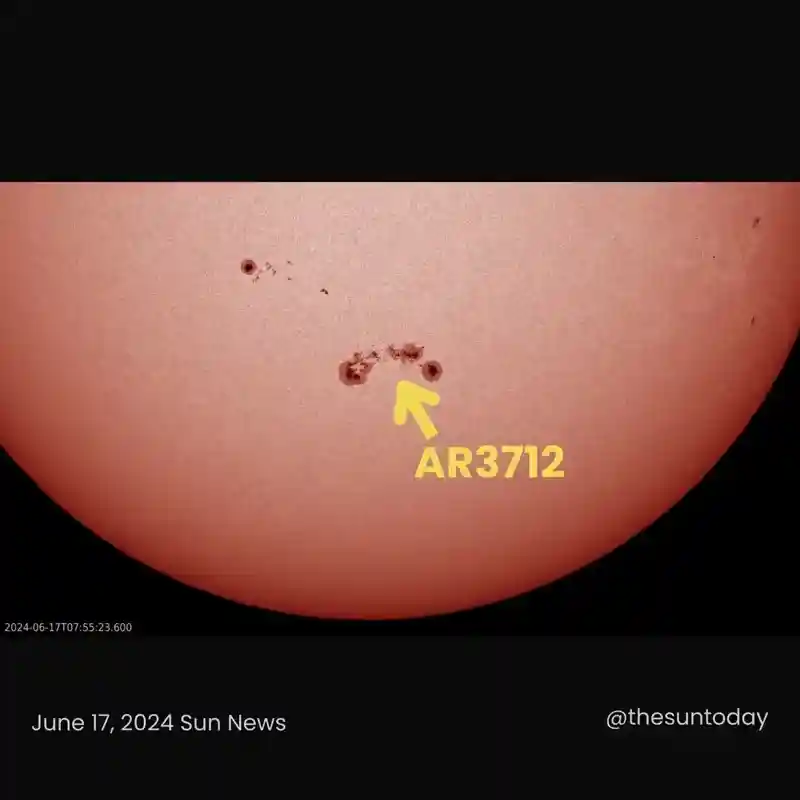
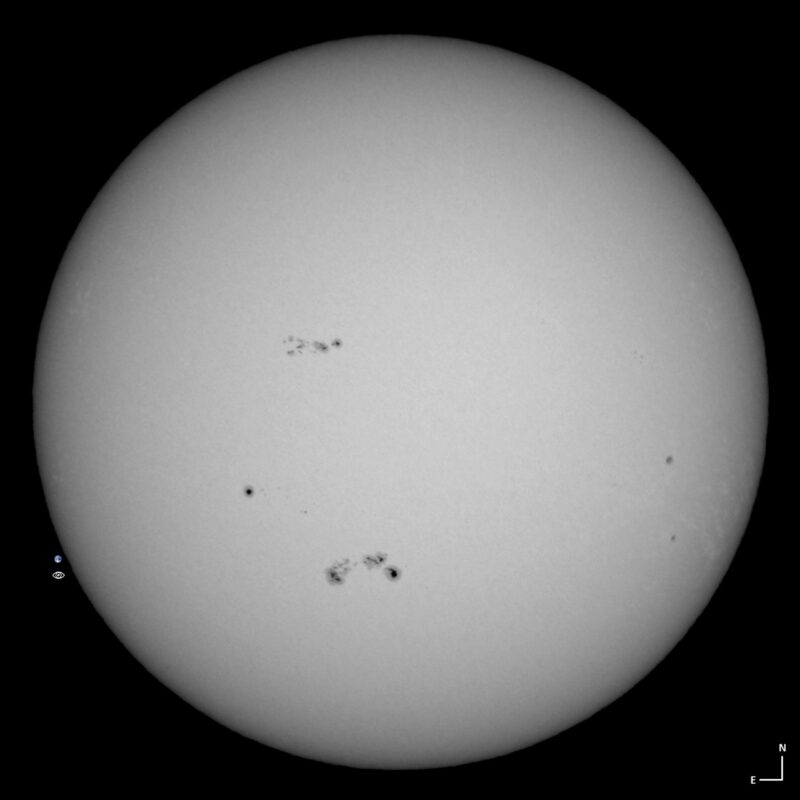
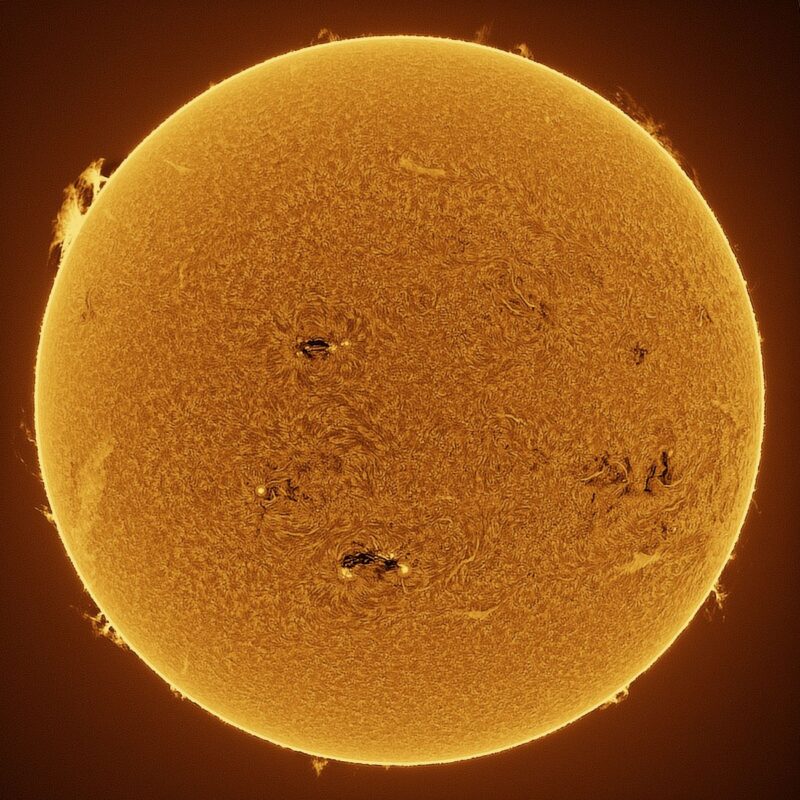
Sun news for June 16, 2024: Eyes remained fixed on sunspot region AR3712
Sunspot region AR3712 continues to grow and produce most of the observed flares on the sun’s Earth-facing disk. Since June 12, the region has increased in size from the area of one Earth to the area of more than five Earths today. Sun activity has decreased to low levels, with only C flares produced over the past 24 hours, but all of the 21 observed flares, save for one, came from AR3712. The region has also maintained its beta-gamma-delta magnetic complexity since June 14. The region has not produced any M flares over the past 24 hours, but it is nearing the central solar meridian, putting it in a prime position to hurl coronal mass ejections (CMEs) earthward. The region has produced more flares than those recorded up to 8:11 UTC today because NOAA Space Weather Prediction Center is experiencing an unscheduled network outage, preventing GOES X-ray flare observations from being updated. The data is more than likely recorded but is not available at the moment. When we look at the sun in the Solar Dynamics Observatory’s (SDO’s) 131 angstrom wavelength channel, we can see the additional flaring. They appear to be at least C-class events, though some could be M-class. We would usually expect to see diffraction spikes (the cross-shaped patterns) in the images for large C, M-class, and X-class events, though this is not always the case for flares below M5. Observations of the solar wind yesterday revealed the arrival of a shock wave around 11 UTC, June 15, and a subsequent G1 (minor) geomagnetic storm followed. The determination of the source is not fully agreed upon, but many believe it was due to the arrival of the expected CME from June 12. This may cause some continued geomagnetic activity through the day. Unfortunately, there have not been notable postings of auroras, at least not yet, if they exist. Most eyes, including ours, are staying focused on AR3712 to wait for any exciting sun surprises.
Last 24 hours: Sun activity has been low during the past day, with the production of only C-class flares. The sun produced 21 C flares between 11 UTC yesterday and 11 UTC today. The largest eruption was a C5.8 flare from active region AR3712 at 18:04 UTC on June 15. All but one of these flares came from AR3712, and the remaining C flare was from region AR3713. There are no flares recorded after 8:11 UTC today, June 16, due to an unscheduled network outage at NOAA SWPC. The sun has seven labeled active regions on its Earth-facing side. Two new large coronal holes emerged on the solar disk in the northeast quadrant and over the solar equator line west of the central meridian.
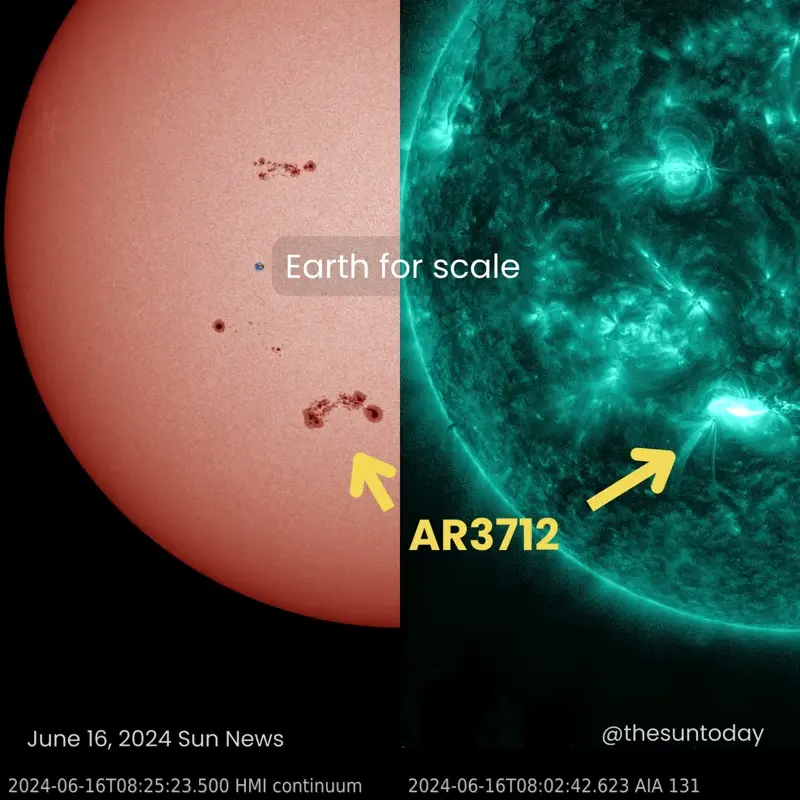

Sun news for June 15, 2024: Sunspot region growing quickly
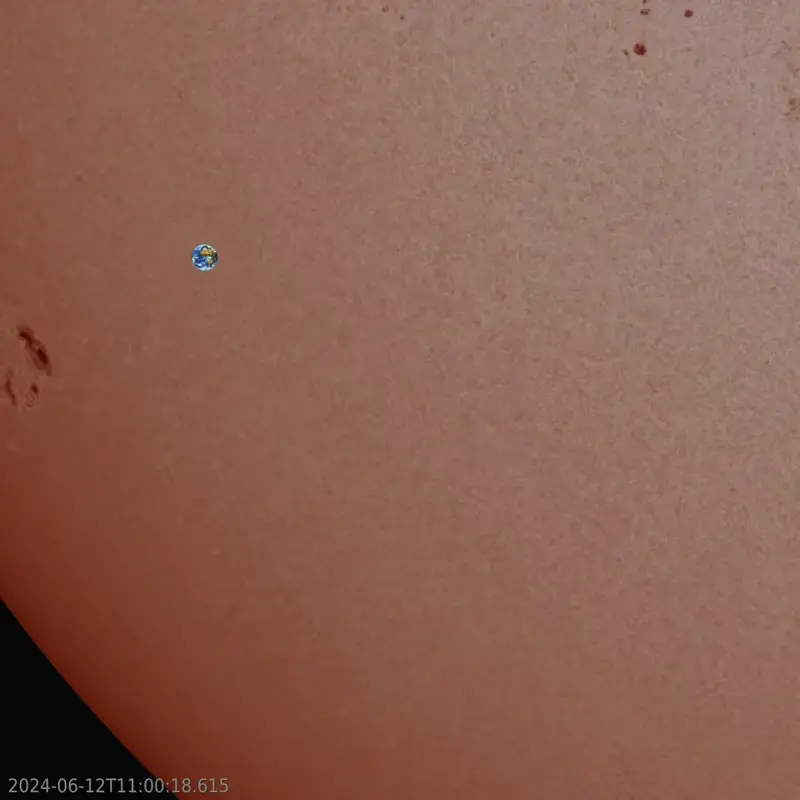
Thanks to an isolated M flare, the sun activity reached moderate levels, along with a notable flaring increase. Flare production climbed to 26 eruptions over the past day. The flaring increase and the M flare are due to the current stand out region, AR3712. Since its appearance, the active region has quickly increased in size and magnetic complexity. It has developed a delta region now with a beta-gamma-delta magnetic configuration. This means the sun has the potential for more M and even X flares. AR3712 is the largest region on the Earth-facing side of the sun. Due to the coronal mass ejection (CME) from AR3711’s M1.2 flare on June 12, there is a chance for an auroral display late today through early tomorrow, June 16.
Last 24 hours: Sun activity is moderate during the past day, with the production of an isolated M-class flare. The sun produced 26 flares between 11 UTC yesterday and 11 UTC today, an M plus 25 C flares. The largest eruption was an M1.3 flare from active region AR3712 at 6:26 UTC on June 15. An R1 (minor) radio blackout affected an area over northeast India. The lead flare producer of the period once again was sunspot region AR3712, which produced 24 of the 26 flares of the period, including the M flare. The sun has six labeled active regions on its Earth-facing side. Two new large coronal holes emerged on the solar disk in the northeast quadrant and over the solar equator line west of the central meridian.
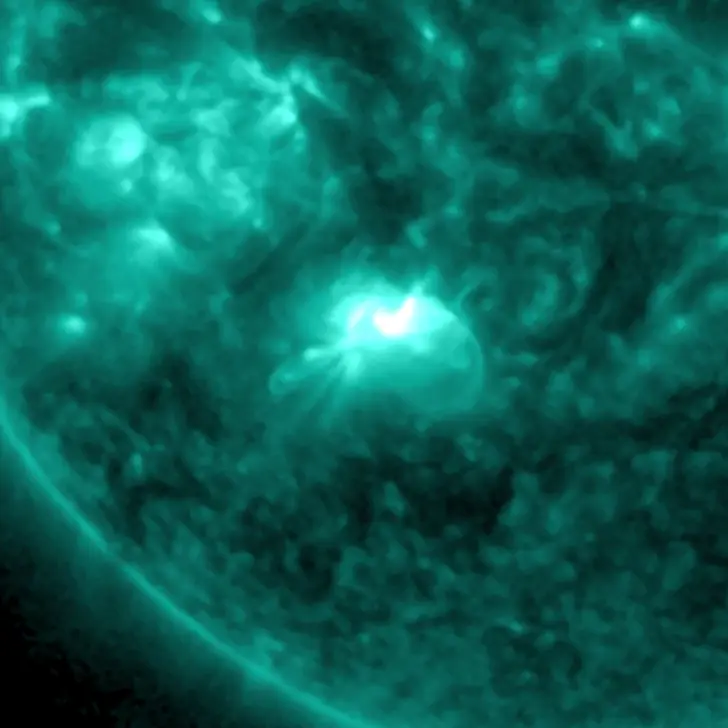
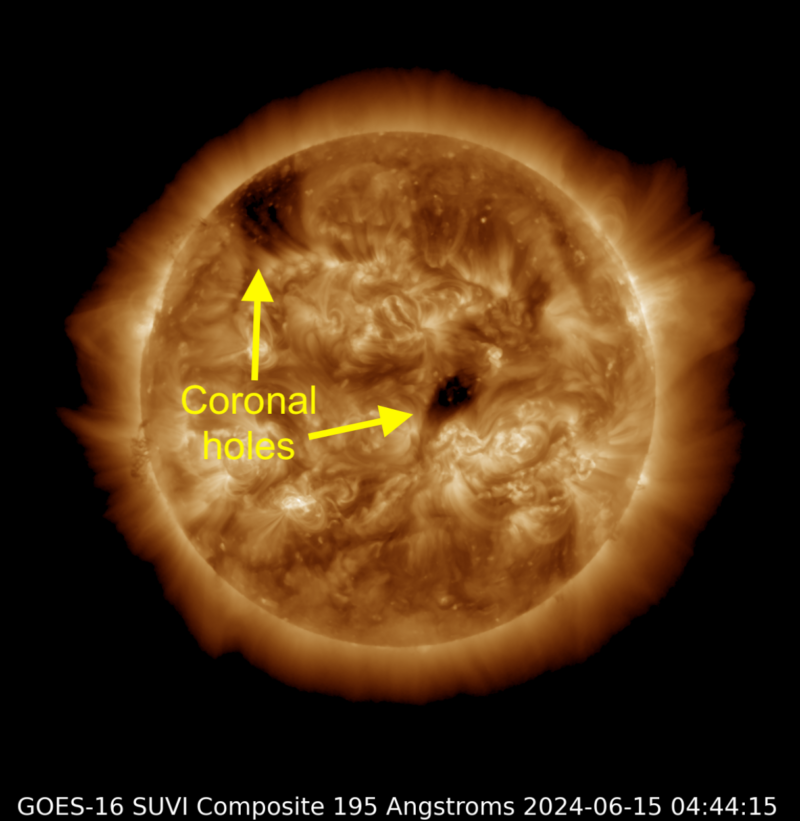
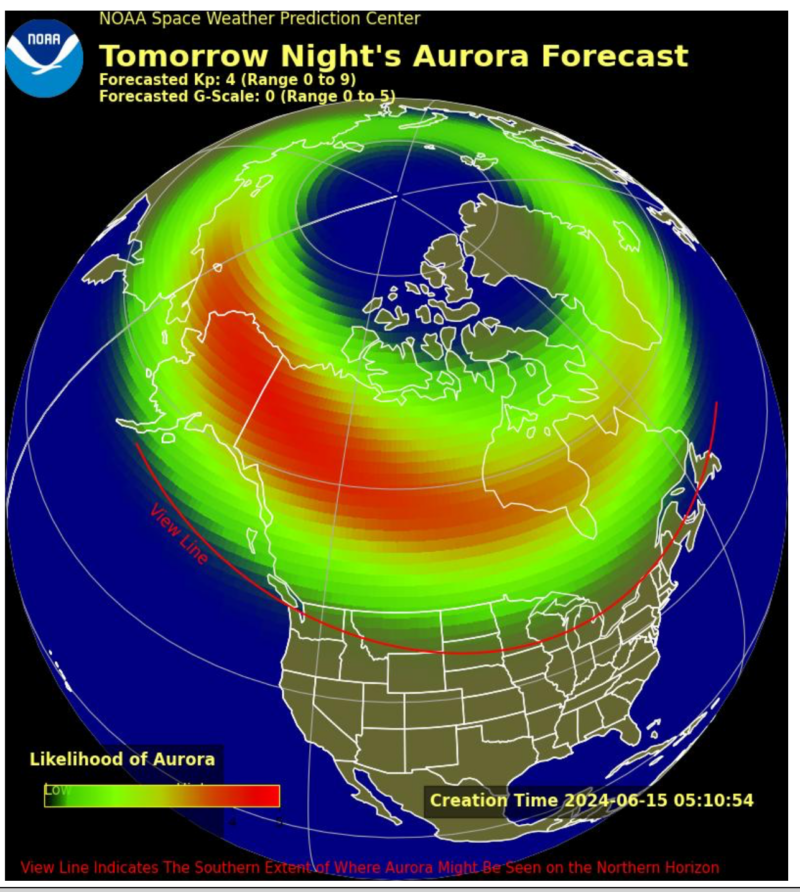

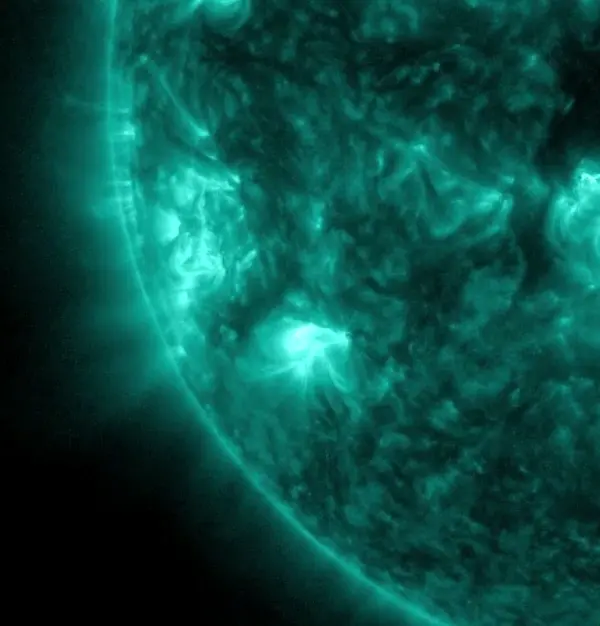
Sun news for June 14, 2024: Two regions churning with activity
Sun activity increased over the past day, with two M flare-producing sunspot regions starting to show some real promise. Notably, AR3712 has developed a beta-gamma-delta magnetic complexity, meaning it has the potential for more M and even X flares. Plus, it’s currently the largest region on the Earth-facing side of the sun. But it was AR3713, which is displaying a beta-gamma magnetic complexity, that produced the largest flare of the last 24 hours: an M3.2 flare. We’ll be keeping a close eye on these two regions!
Last 24 hours: The solar radiation storm we saw during the last couple of days has started to reside. The storm was caused by a big eruption from AR3697 on the opposite side of the sun. Sun activity has remained at moderate levels over the past day, but flaring production saw an increase to 16 flares. Two of the flares produced between 11 UTC yesterday and 11 UTC today were M-class, and the rest were C-class. The lead flare producer was region AR3712 in the southwest. It produced nine M flares and eight C flares. The second most productive region was AR3713 with six flares, including an M3.2 – the largest flare of the period – at 16:45 UTC on June 13. The event caused an R1 (minor) radio blackout affecting an area over the Bahamas. At 4:43 UTC on June 14, AR3712 produced the second M of the day, an M2.4. Its corresponding R1 (minor) radio blackout was centered over Taiwan. The sun currently has nine labeled active regions on its Earth-facing side.



Sun news for June 13, 2024: Quiet, with 1 M and a huge filament eruption
Okay, we’re in a bit of a lull, following the intense activity we saw last week. Sun activity is still considered moderate thanks to an isolated M1.2 flare by active region AR3711 blasted at 22:46 UTC on June 12. Otherwise, only seven flares were produced in the past day. AR3697 is still producing eruptions that we can still see, but this region is now far beyond the solar horizon in the west, hidden from our view. But we did see a huge prominence in the southwest, from beyond the solar horizon. It was likely produced by our hero, AR3697. And we saw a huge filament eruption in the sun’s southeast, starting at around 11 UTC on June 12. The large filament that exploded extended from the solar equator down southeastward, crossing the whole southeast quadrant. The blast hurled material into space. Specialists are performing their modeling and analysis trying to find out if any component of the coronal mass ejection (CME) is coming our way at Earth.
Last 24 hours: Sun activity is moderate with the production of an isolated M flare. Flaring productivity is still at the low, only six faint C flares added the mentioned M for a total of seven eruptions during our observation period. The largest, the M, was an M1.2 by AR3711 at 22:46 UTC on June 12. An R1 (minor) radio blackout was registered affecting an area over the Pacific Ocean off the west coast of Hawaii. Honors for the lead flare producer of the day was shared between AR3711 and AR3709. Both produced two flares each, AR3711 in addition, was the producer of the M flare of the day. Currently the sun has 10 labeled active regions on its Earth-facing side. There are three newcomers that each got a number: AR3714, AR3715 and AR3716. All three are on the sun’s northeast quadrant. Only AR3712 shows a beta-gamma magnetic complexity, suggesting a potential for flaring. The rest look stable or in decay bearing alpha or beta configurations.
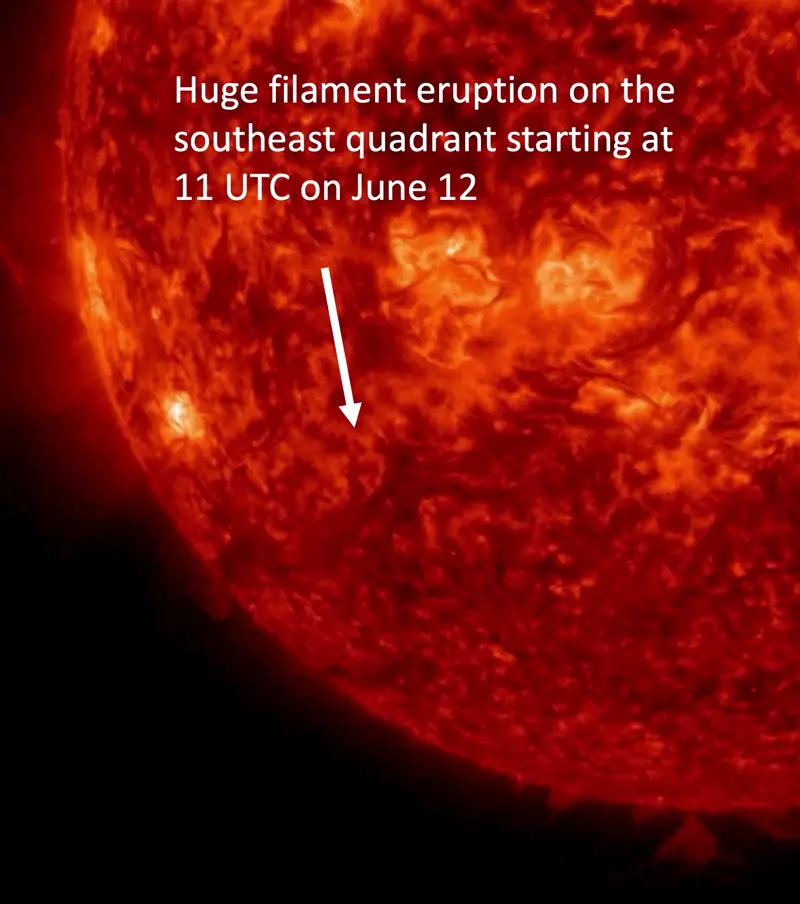
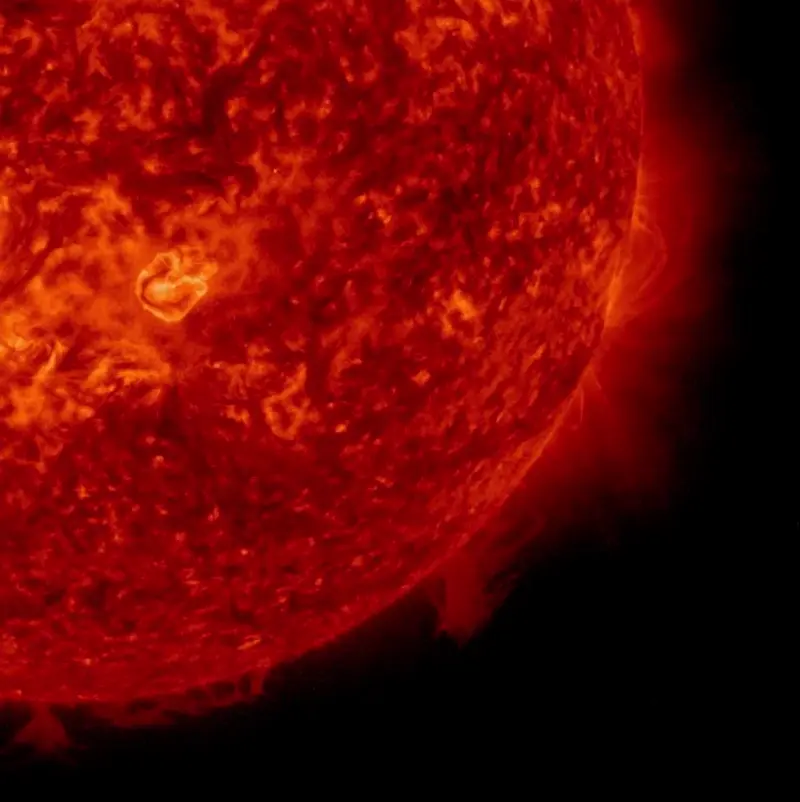
Sun news for June 12, 2024: A far-side blast and a sun-diving comet
Sunspot region AR3697 is beyond the sun’s limb (edge) now, but continues to flare! At around 23:06 UTC on June 11, SOHO’s LASCO C3 observed a partial halo CME. That sort of event can indicate a coronal mass ejection (CME) coming toward Earth. But it’s not likely in this case; there was no eruption on the Earth-facing side. Just before the eruption, we spied a sun-diving comet in the LASCO C2 and C3 images. Can you see it in the image above? Bam! The eruption occurred as the comet evaporated (probably) in the solar corona. Despite being on the far side now, AR3697 is still magnetically connected to Earth, which became apparent when a small increase in high-energy protons (solar energetic particles) was seen just after the eruption. Stay tuned for more sun news.
Last 24 hours: Now that sunspot region AR3697 has departed – carried out of view over the sun’s southwest limb (edge) by the sun’s rotation – sun activity overall has returned to low levels. And the chance for M flares dropped from 70% yesterday to 50% today, while chances for X flares dropped from 25% down to 10%. Goodbye AR3697! Gone, but not forgotten! During the past day, this region produced the partial halo event described above, plus what looked to us like a couple of C flares. They were likely larger, but the sun is now partly blocking our view of the eruptions. Over the past day, the sun reduced in flaring productivity overall, from 16 flares yesterday to only 10 flares in the past day (11 UTC yesterday to 11 UTC today). The largest flare was a C3.6 from an incoming, as-yet-unnumbered region in the southeast. The event occurred at 5:21 UTC on June 12. The lead flare producer was active region AR3711, which produced three Cs. Active region AR3703 lost its beta-gamma complexity and now shows only a beta configuration, indicating a lowered potential for flaring. The rest of the active regions on the Earth-facing side have stable alpha or beta configurations. There are five numbered regions on the solar disk.
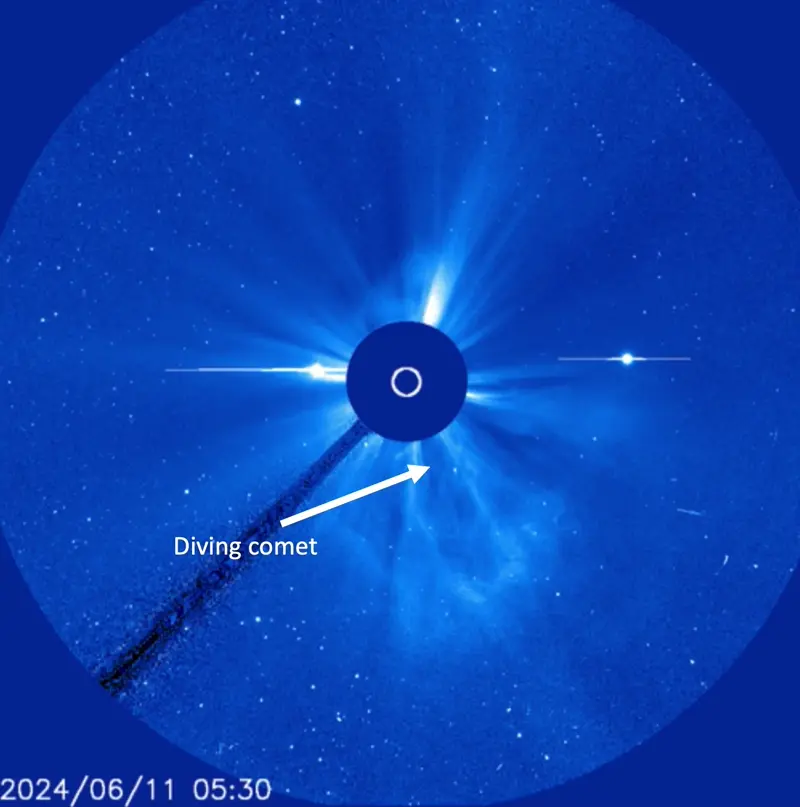
Sun news for June 11, 2024: Activity beyond the limb
Today sun activity is high thanks to an M9.6 flare from AR3697. This active region continues to be the lead flare producer despite its location beyond the solar limb. It has just rotated out of view. During the past day, AR3697 produced two Ms in all, plus another 14 Cs. That’s after three Ms and an X flare during one 4-hour period – all from beyond the solar limb, or edge – in the 24 hours before that. In related news, it’s now official, the near-X flare (an M9.8) from AR3697 on June 8 created the strongest proton, or solar energetic particle, storm since 2017. It peaked at NOAA S3 radiation storm levels and reduced to S2 level for an extended period through June 10. Spaceweather forecaster Shawn Dahl of SWPC talked about this storm, and others like it, with Deborah Byrd in yesterday’s livestream.
Last 24 hours: Sun activity remains at high levels with the release of an M9.6 flare. During the past day, the sun produced 16 flares: two M flares and 14 C flares. The largest event was the M9.6 flare from AR3697 at 18:40 UTC on June 10. An R2 (moderate) radio blackout affected an area over Mexico. (Note, we are taking out yesterday’s including the X1.6 flare in today’s report. It peaked at 11:03 on June 10 but started within the boundaries of yesterday’s report.) The other M flare of this period was an M1.6 flare from AR3697 at 13:29 UTC on June 10. An R1 (minor) radio blackout affected an area over the Atlantic Ocean off the west coast of Africa. The lead flare producer of the period was region AR3697, with 13 flares: 11 Cs and two Ms. This sunspot region, AR3697, despite being over the limb, kept up a high level of flaring. Because the sun partly occulted (blocked) the flares, their observed strength was lower than their actual strength. The last time we could observe the region’s magnetic complexity, it was beta-gamma-delta, which is consistent with its recent activity. AR3703 shows beta-gamma complexity. The rest of the labeled active regions show either an alpha or a beta. On the Earth-facing solar disk, there are seven numbered active regions.
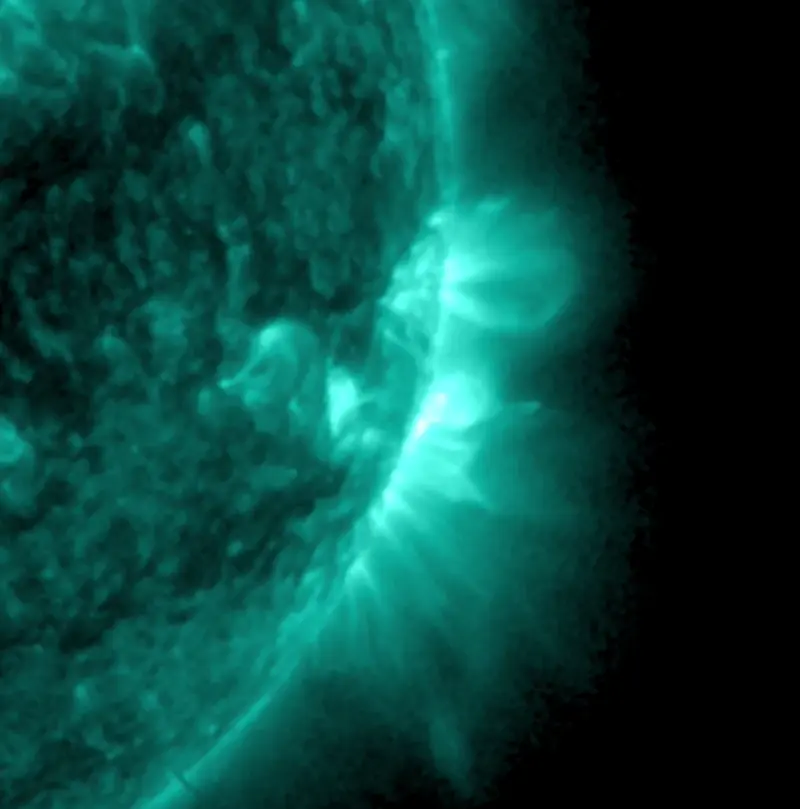
Sun news for June 10, 2024: X flare! AR3697 goes out with a bang
Bam! As we write this (around 11:30 UTC on June 10), AR3697 is in the process of firing off a double flare, an M5.5 plus an X1.5, from just over the western limb (edge). The M5.3 began at 10:18 UTC, and the X1.5 peaked around 11:25 UTC. They are part of the same eruption of magnetic energy, and given the region’s position just over the limb (edge), they are most certainly larger than they appear. That’s because the flares were partially occulted (blocked) by the sun. The X flare created an R3 (strong) radio blackout over North Africa. This blackout combined with the polar cap blackout, which was already underway due to the proton or solar energetic particle event created by the near-X flare from AR3697 on June 8. The region may have some more excitement under its belt from beyond the limb (edge). Auroras are still expected at high latitudes tonight with the anticipated arrival of a coronal mass ejection (CME) from June 8. Stay tuned!
Last 24 hours: Sun activity has reached high levels, with the production of an X flare and four M flares. The sun released 17 flares: one X, four Ms, and 12 C flares. The largest event was an X1.6 flare from AR3697 at 11:03 UTC on June 10. An R3 (minor) radio blackout affected an area over North Africa. The X and M flares during the observation period were:
– M1.0 by AR3703 at 19:50 UTC on June 9. R1 (minor) radio blackout over the Pacific Ocean east of Hawaii.
– M3.3 by AR3709 at 05:58 UTC on June 10. R1 (minor) radio blackout over Asia.
– M2.3 by AR3709 at 09:38 UTC on June 10. R1 (minor) radio blackout over North Africa and the Middle East.
– M5.3 by AR3709 at 10:18 UTC on June 10. R2 (moderate) radio blackout over North Africa.
– X1.6 by AR3697 at 11:03 UTC on June 10. R3 (strong) radio blackout over North Africa. Largest flare of the day.
The lead flare producer of the period is region AR3697, with 13 flares: an X, four Ms, and eight Cs. Sunspot region AR3697, now over the southwest limb (edge), has departed with a spectacular show, but don’t count it out yet. It may still produce some large events partially visible from over the limb (edge). It kept its beta-gamma-delta magnetic configuration as far as we were able to tell. On the Earth-facing solar disk, there are eight numbered active regions.
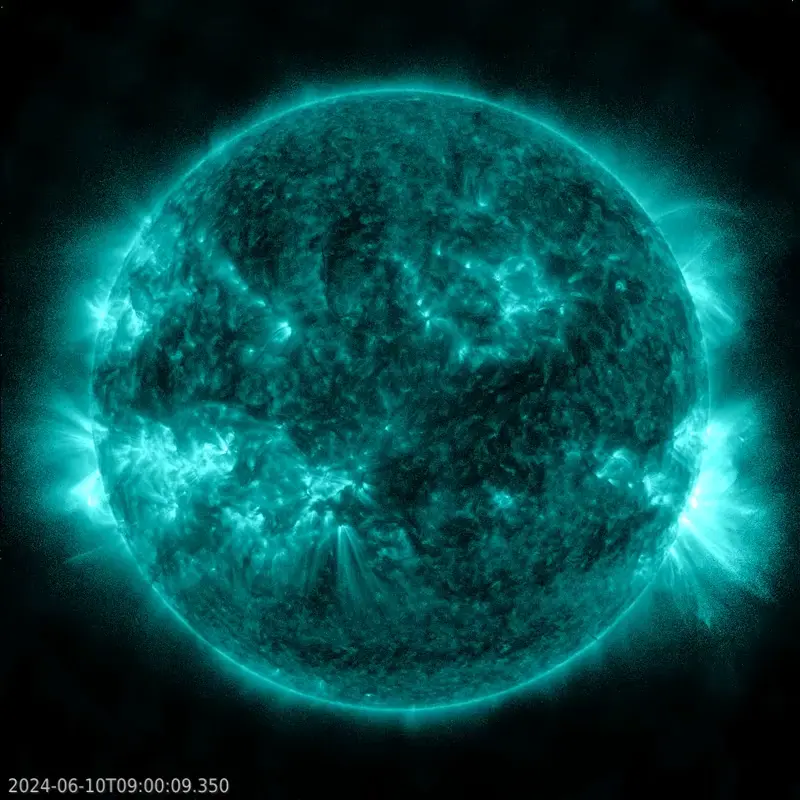
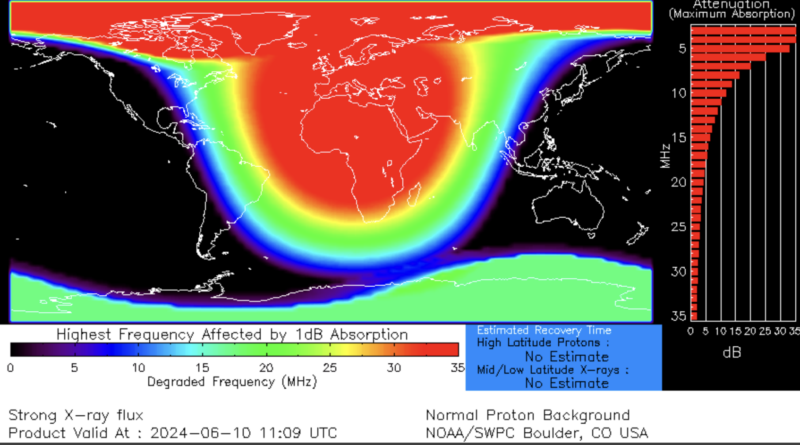
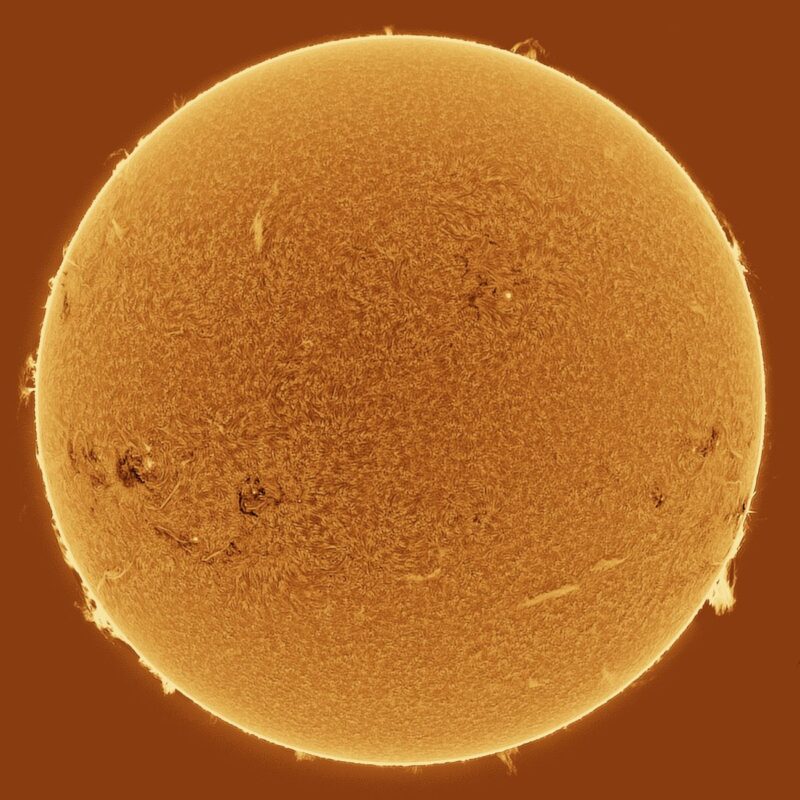
Sun news for June 9, 2024: 3 M flares. Auroras possible tomorrow
After the storm, a calm. The sun produced three M flares during the past day; detail below. Remember a year ago – when the sun was still climbing to solar maximum – and thought three M flares was a huge deal? Now that the sun activity is peaking for this 11-year cycle, things are different, and we’re reporting 3 M flares as a calm. Ho hum. Three Ms! The almost-X flare we reported on yesterday – an M9.8 from AR3697 – was accompanied by a huge filament eruption that hurled a giant bubble of sun-stuff into space. After modeling and analysis, specialists found a component of this coronal mass ejection (CME) coming our way at Earth. An estimated arrival is by late June 10. The impact will bring chances for G1 (minor) to G2 (moderate) geomagnetic storming, with likely auroral displays at high latitudes at least. Don’t put up those cameras just yet.
Last 24 hours: Over the past 24 hours, sun activity returned to moderate levels, with the production of three M flares. We saw the sun blast out a total of 18 flares in the past day, three Ms and 15 C flares. The largest was an M1.7 flare by AR3697 at 7:01 UTC on June 9. An R1 (minor) radio blackout was observed affecting an area over India. This is the breakdown of the M flares during the period:
– M1.0 by AR3703 at 21:02 UTC on June 8. R1 (minor) radio blackout over the Pacific Ocean east of Hawaii.
– M1.7 by AR3697 at 7:01 UTC on June 9. R1 (minor) radio blackout over India. Biggest flare of the day.
– M1.2 by AR3709 at 9:19 UTC on June 9. R1 (minor) radio blackout over Oman.
The lead flare producer of the period is region AR3697 with 13 flares, an M and 12 Cs. Sunspot region AR3697, which is now approaching the southwest limb (edge), is departing with a spectacular show. It kept its beta-gamma-delta magnetic configuration. Sunspot region AR3703 is now showing a beta-gamma configuration. This may be the next active region to watch. On the Earth-facing solar disk, there are nine numbered active regions.
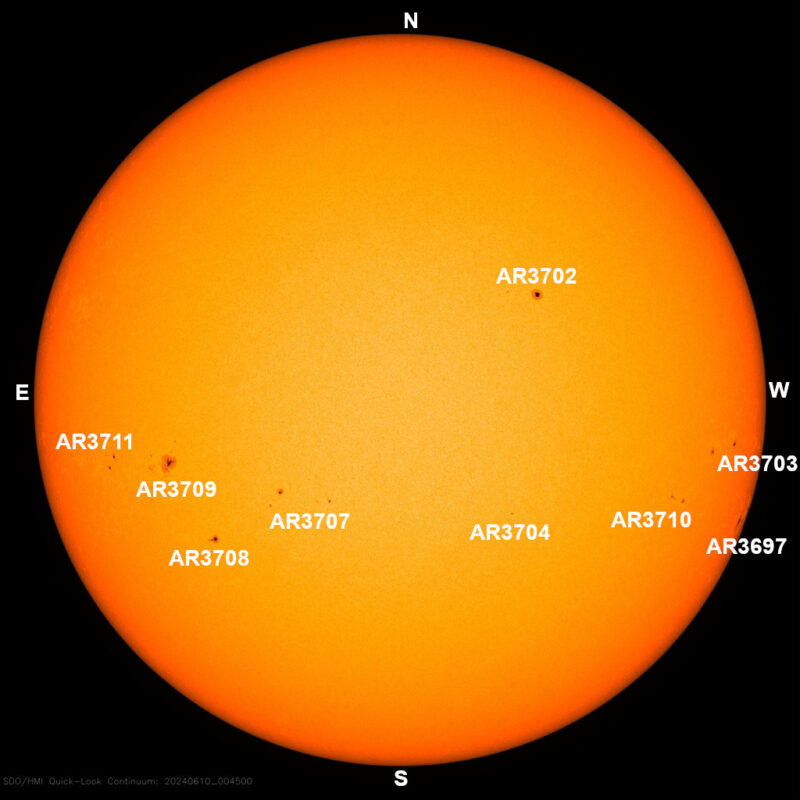
Sun news for June 8, 2024: Almost-X flare, big eruption, particle storm
The giant sunspot region AR3697 is awake again. It’s the historic sunspot group that produced the largest flare of Solar Cycle 25 (so far) and one of the largest geomagnetic storms recorded in this solar cycle. Nearing the end of its current trip over the Earth-facing side of the sun’s disk, it produced an almost X flare, an M9.8. A spectacular filament eruption occurred in conjunction with the flare. This massive energy release drove a huge shock wave, accelerating protons and electrons to nearly the speed of light. These solar energetic particles traveled along the solar magnetic field connected to Earth, showering the SOHO/LASCO cameras. This created the characteristic snow on the coronagraph images. The solar energetic particle event triggered an NOAA S3 radiation storm alert, like Kp on a scale of 5. The radiation storm level is reduced to an S2 level. At Earth, an unexpected G2 (moderate) geomagnetic storm occurred at 17:59 UTC on June 7 (Kp = 6) due to a transient coronal structure impacting Earth’s magnetosphere. Stay tuned for more sun news.
Last 24 hours: Sun activity reached high levels with an almost X, M9.8 flare. Our star produced 23 flares, seven M flares, and 16 C flares. The largest was the M9.8 flare from AR3697. The region released M flares all during our observation period between 11 UTC yesterday and 11 UTC today. The flare occurred at 1:49 UTC. The list of the M flares during the period is:
-M1.3 by AR3697 at 16:22 UTC on June 7. R1 (minor) radio blackout over Puerto Rico.
-M1.8 by AR3708 at 00:28 UTC on June 8. R1 (minor) radio blackout over the Pacific Ocean.
-M3.4 by AR3697 at 00:51 UTC on June 8. R1 (minor) radio blackout over the Pacific Ocean.
-M9.8 by AR3697 at 01:49 UTC on June 8. R2 (moderate) radio blackout over the Philippine Sea.
-M1.6.by AR3697 at 03:18 UTC on June 8. R1 (minor) radio blackout over over the Philippine Sea.
-M1.5 by AR3709 at 05:28 UTC on June 8. R1 (minor) radio blackout over Bangladesh.
-M1.2 by AR3709 at 08:44 UTC on June 8. R1 (minor) radio blackout over the Arabian Peninsula.
-M1.2 by AR3697 at 08:58 UTC on June 8. R1 (minor) radio blackout over the Arabian Peninsula.
The lead flare producer of the period is region AR3697 with 17 flares, five Ms, and 12 Cs. Sunspot region AR3697, which is now approaching the southwest limb (edge), is departing with a spectacular show. It kept its beta-gamma-delta magnetic configuration. On the Earth-facing solar disk, there are nine numbered active regions. The only newcomer is AR3709.
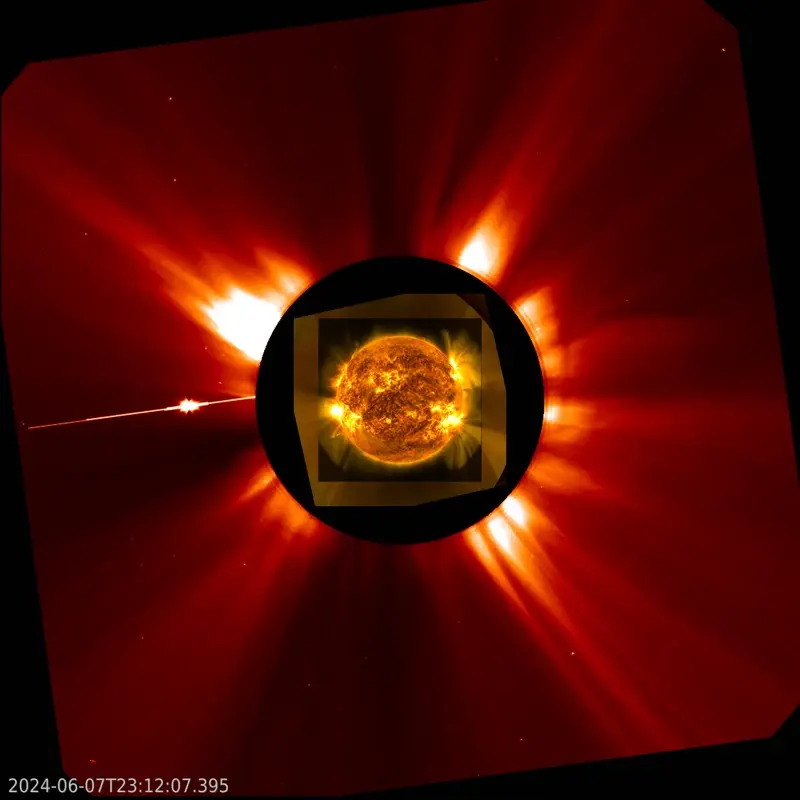
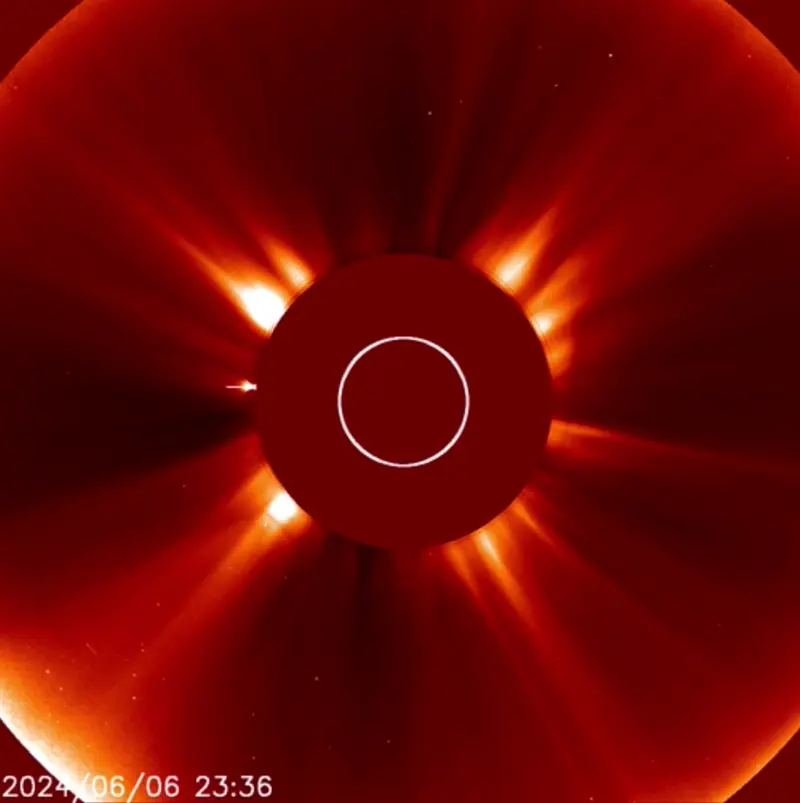
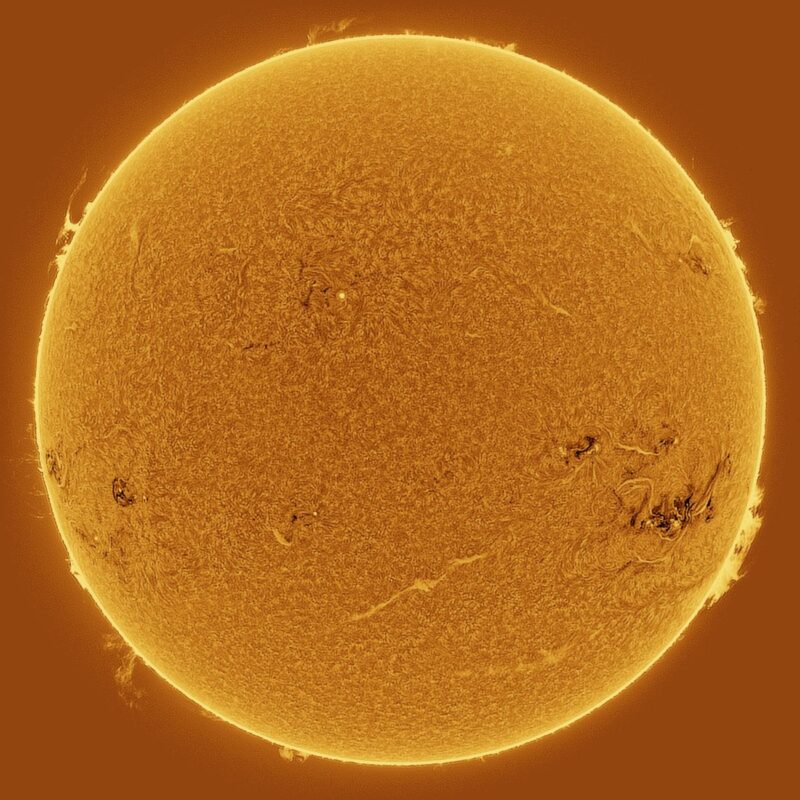
Sun news for June 7, 2024: Activity inches back to high
After a brief dip in activity, sun activity has returned to high with the production of an M6.1 flare by the lead flare producer of the week, sunspot region AR3697. The flare was blasted at 15:06 UTC on June 6 and it provoked an R2 (moderate) radio blackout affecting an area over the Atlantic Ocean. This was followed by a second M flare, an M4.1, by an incoming as-yet-unnumbered active region in the southeast. We also observed a lot of activity all around the solar periphery over the past day. A gorgeous filament – a rope of solar material and magnetic fields – erupted on the southeast limb (edge), and a long-lasting filament is sitting over the northeast limb as a prominence. Most of the sun’s active regions are on or near the limbs (edges), with lead active region AR3697 approaching the western limb. As the old guard departs, stay tuned to see what’s coming into view in the east.
Last 24 hours: Sun activity increased to high with the production of two M flares, including an M6.1 flare. The sun produced 14 flares in total: two M flares and 12 C flares. The largest flare was the M6.1 flare. At the time of writing (9:13 UTC on June 7), an incoming region in the southeast was firing the second M flare, an M4.1. The blast caused an R1 (minor) radio blackout over the Arabian Peninsula. The lead flare producer of the past day, and the week, was sunspot region AR3697, which is now approaching the southwest limb (edge). Keeping its beta-gamma-delta magnetic configuration, it is now the “oldest” numbered active region. On the Earth-facing solar disk there are currently nine numbered active regions. Two are newcomers: AR3707 and AR3708, both in the southeast quadrant.

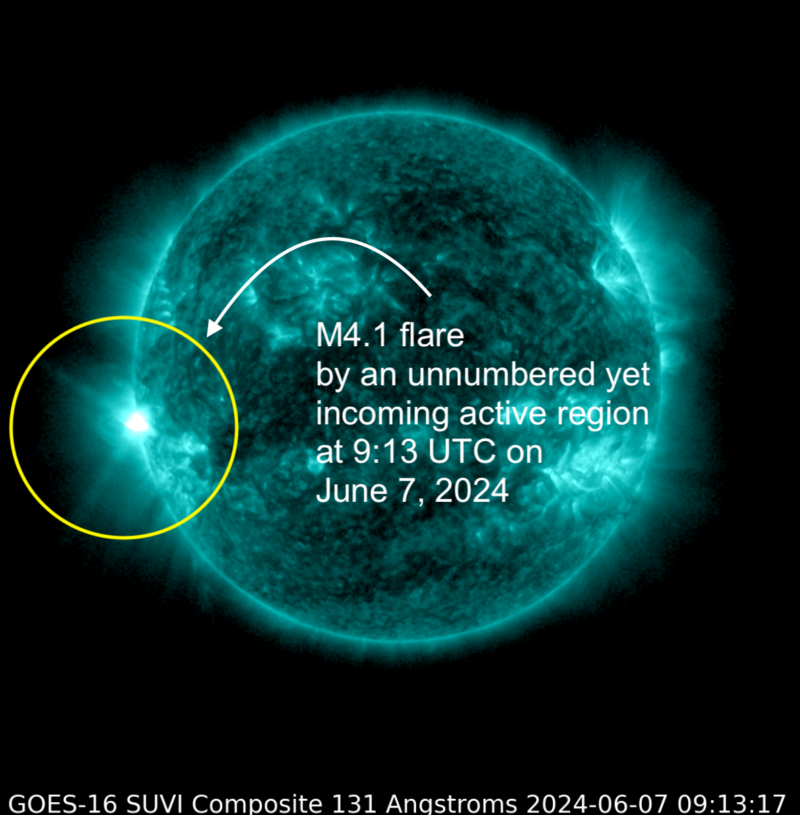
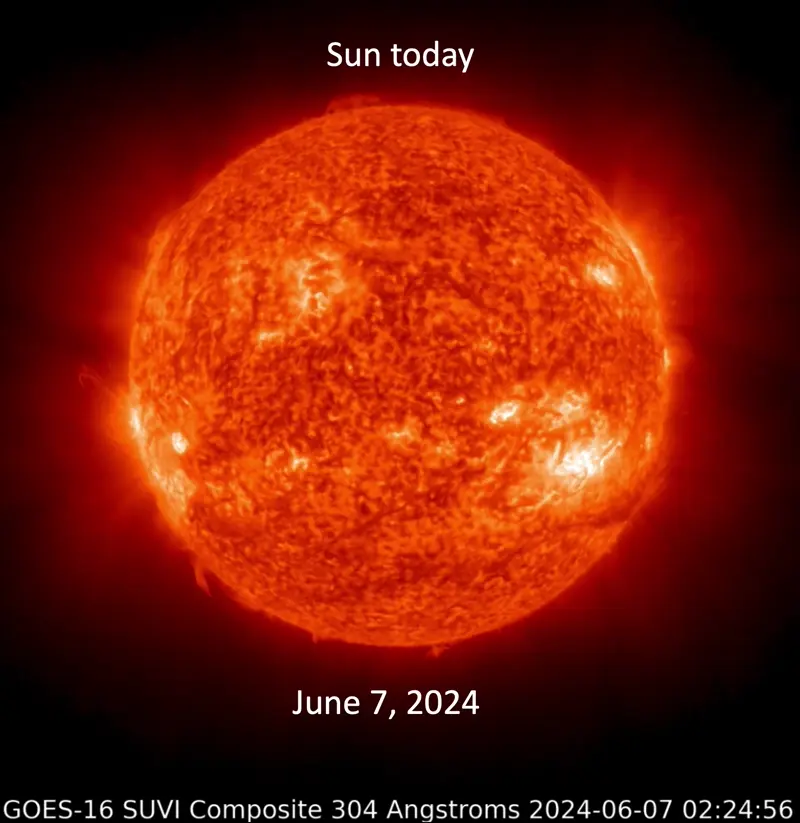
Sun news for June 6, 2024: May was peak of Solar Cycle 25 so far
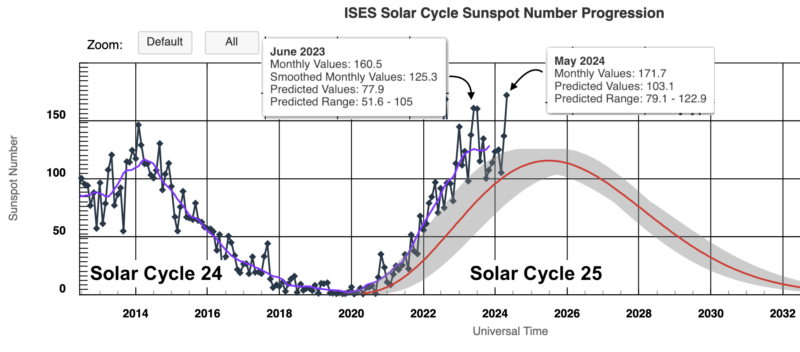
It’s official: May was the most active month in Solar Cycle 25 so far. It certainly felt that way, with multiple X flares – including the largest flare of Solar Cycle 25 so far – and many coronal mass ejections (CMEs) that provoked an historic geomagnetic storm. And now the official results are out; May had a sunspot number of 171.1, the highest in Solar Cycle 25 so far. The sunspot number is a way of evaluating the sun’s long-term activity level, based on an estimate of the number of sunspots on the whole sun. May surpassed June 2023’s value of 160.5, which held the title for almost a year. And May 2024 is the highest point seen since September 2001, when the sunspot number reached 238.2. Will June 2024 surpass May? It’s looking promising so far! Stay tuned.
Last 24 hours: Sun activity has dropped to low after only C flares were produced during the past day. The sun fired 14 C flares in total, the largest being a C9.5 by an as-yet-unnumbered incoming region on the southeast at 0:14 UTC on June 6. Sunspot region AR3697 was the leading flare producer with 5 C flares, and still bears a beta-gamma-delta magnetic configuration. But it is no longer the largest region on the solar disk, competing now with AR3703 and AR3698. The sun currently has eight labeled sunspot regions on its Earth-facing side as three of the eleven we saw yesterday decayed and vanished.
Sun news for June 5, 2024: Two M flares from decaying giant sunspot

Sunspot region AR3697 – famous for firing the largest X flare of Solar Cycle 25 so far and for helping to cause the global geomagnetic storms on May 10 – has started to show signs of decay. But it’s not done yet! It’s still holding on to its high-potential beta-gamma-delta magnetic configuration, and fired two M flares over the past 24 hours. We’ll have to wait and see if this region fades away completely before rotating off the Earth-facing solar disk for the second time. Sitting just above AR3697 is an interesting sight: a group of sunspot regions angled in an apparent straight line from east to west just under the equator. Take a look below. This is largely just a result of perspective, given that we are seeing a 2D projection of a 3D object, but it’s cool nonetheless!
Last 24 hours: Solar activity maintained moderate levels during the past day, with two M flares. The largest flare of the period was an M3.5 flare from AR3697, ongoing at the time of writing (8:56 UTC). The flare has produced an R1 (minor) radio blackout over the Arabian Peninsula. During our observation period, from 11 UTC yesterday to 11 UTC today, the sun produced 13 flares: two M flares and 11 C flares. AR3697 produced five of these: three Cs and the two Ms. The sun currently has 11 labeled sunspot regions on its Earth-facing side. There is a newcomer, numbered AR3706, that emerged in the southeast quadrant.
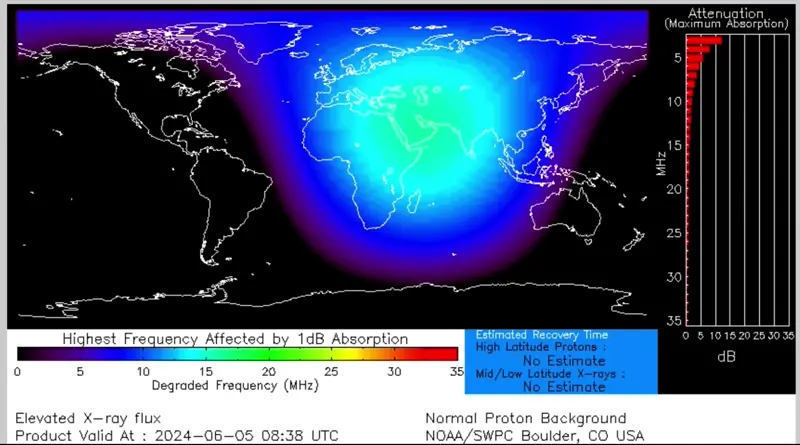
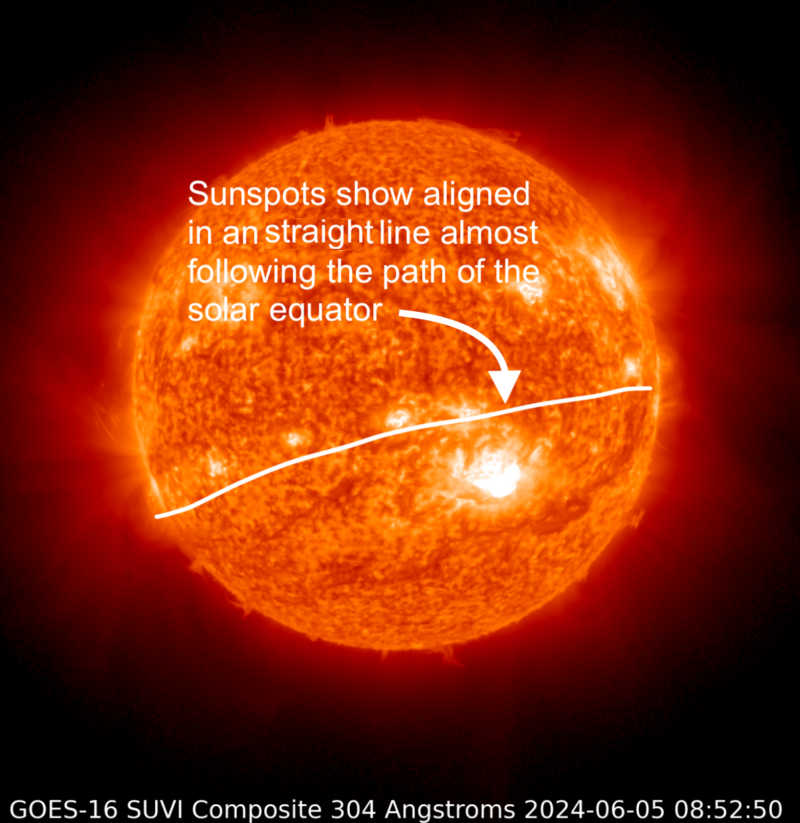
Sun news for June 4, 2024: Beautiful eruption. More auroras?
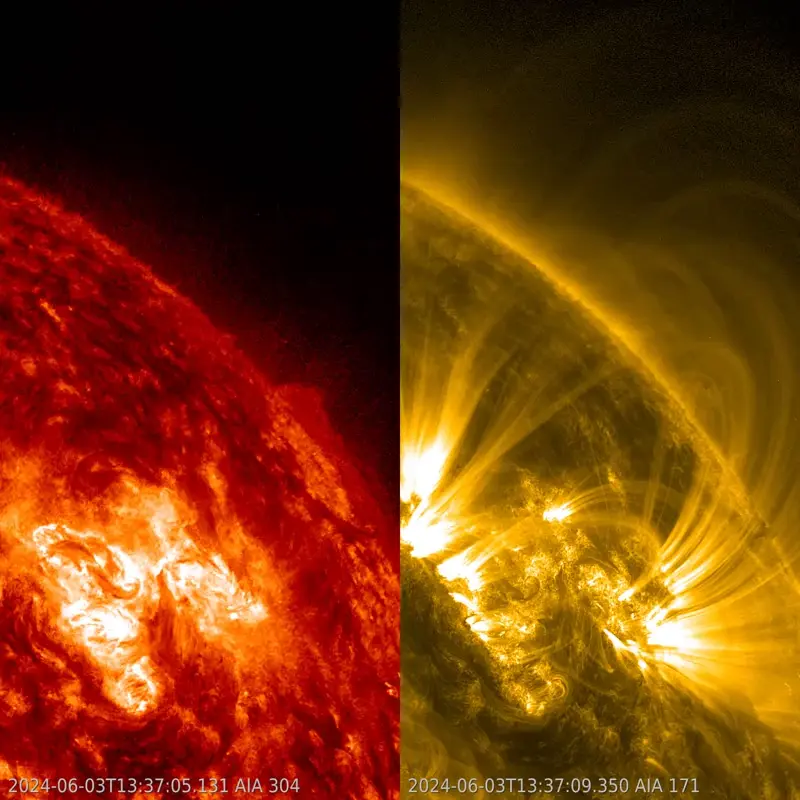
A bubble of sun-stuff hit Earth earlier today. It caused a G1 (minor) geomagnetic storm, observed around 0 UTC on June 4. This coronal mass ejection (CME) was associated with the M7 solar flare on June 1. Another blast of sun-stuff is anticipated later on today, bringing the chance for auroral displays tonight! Get ready, clean lenses, take beautiful photos, and share them with us. Turning back to our star, sun activity has stayed at moderate levels, with five M flares during the past day. AR3697 kept its beta-gamma-delta magnetic configuration, continuing its status as an important player in solar activity. At 12:27 UTC on June 3, a sigmoid (S-shaped) structure formed on the sun after the region released an M2.8 flare. Shortly afterwards, a sigmoid filament erupted from AR3695, at the same time releasing the largest flare of the day, an M4.8 at 14:11 UTC. A filament, many hundreds of thousands of miles long, is stretched along the southeast quadrant. This plasma structure is an Earth-directed eruption possibility. We will keep an eye out. By the way, the X flare potential is still large, at 35%. Stay tuned.
Last 24 hours: Sun activity remains at moderate levels, with the production of four M flares over the past day. The largest was an M4.8 flare from AR3695 at 14:11 UTC on June 3. The flare caused an R1 (minor) radio blackout. During our observation period, 11 UTC yesterday to 11 UTC today, the sun produced 17 flares, five Ms, and 12 Cs. AR3697 continues as the lead flare producer; it produced eight flares, four Ms, and four Cs. The list of M flares of the period:
– M3.2 from AR3697 at 11:55 UTC on June 3. R1 (minor) radio blackout over Yemen.
– M2.8 from AR3697 at 12:27 UTC on June 3. R1 (minor) radio blackout over Mauritania.
– M4.8 from AR3695 at 14:11 UTC on June 3. R1 (minor) radio blackout over the Atlantic Ocean.
– M2.4 from AR3697 at 06:31 UTC on June 4. R1 (minor) radio blackout over Mount Everest.
– M1.7 from AR3697 at 09:04 UTC on June 4. R1 (minor) radio blackout over the Arabian Peninsula.
AR3697 showed some decay, but kept its beta-gamma-delta magnetic configuration. So it still has the potential for more M and X flares. The sun has nine labeled sunspot regions on its Earth-facing side. There are two newcomers on the solar disk. AR3703 emerged close to the solar equator and AR3704 near the limb (edge), both in the southeast quadrant.
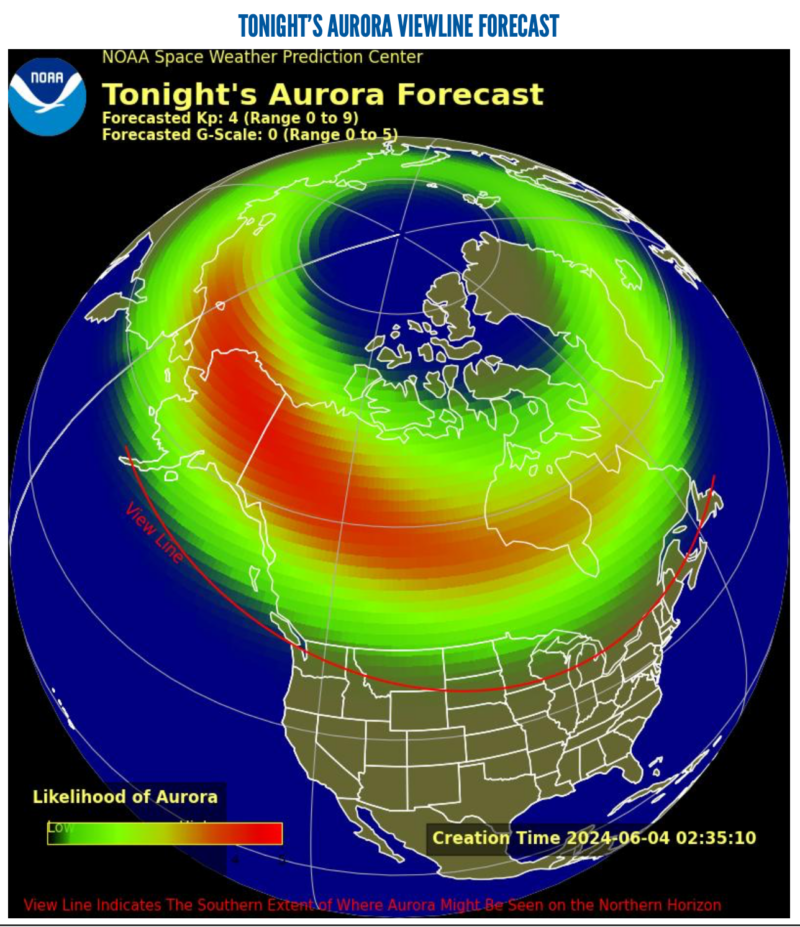
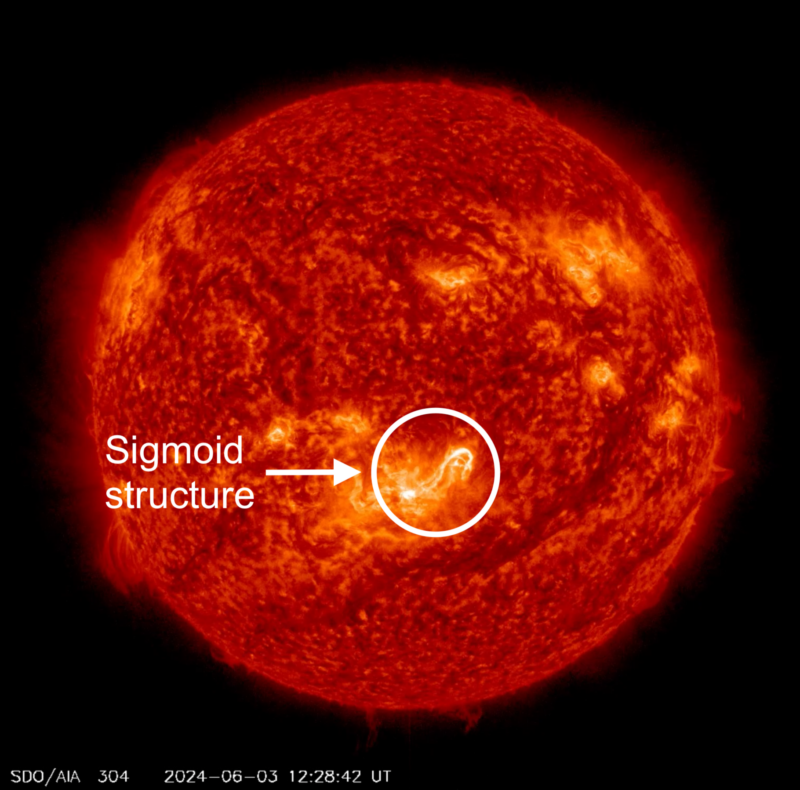
Sun news for June 3, 2024: A little sun-stuff heading our way
When the weekend started, the sun was blasting out X flares like crazy. But, in the past 24 hours, it has calmed down, with only one M1 flare and multiple C flares from AR3697 (the source of the Xs). We note that the potential for X flares is still at a whopping 35% today. Also, AR3697 did release a coronal mass ejection (CME) with an Earth-directed component. We’re not expecting a direct impact, but this CME is expected to increase geomagnetic activity from active to G1 (minor) geomagnetic storm levels. And this bump in activity should bring auroral displays to the higher latitudes. In other exciting sun news, Venus is going directly behind the sun, beginning today. This is the “occultation” of Venus by the sun. Or we can call it an anti-transit of Venus. And we can call it a conjunction of Venus with the sun. Conjunctions of Venus with the sun happen often. But this one is unusual because Venus will pass directly behind the sun: the anti-transit. The LASCO 2 imager on NASA’s SOHO spacecraft observed Venus just before it began its transit. See that image below!
Last 24 hours: Solar activity has decreased to moderate, with a single M1.0 flare from AR3697 at 4:59 UTC on June 3. AR3697 remained the lead flare producer, with nine C flares and the single M flare. The M flare caused an R1 (strong) radio blackout over Asia. AR3697 maintained its beta-gamma-delta magnetic configuration, meaning it has the potential for more M and X flares. The sun currently has 10 labeled sunspot regions on its Earth-facing side. A newcomer was numbered AR3702.
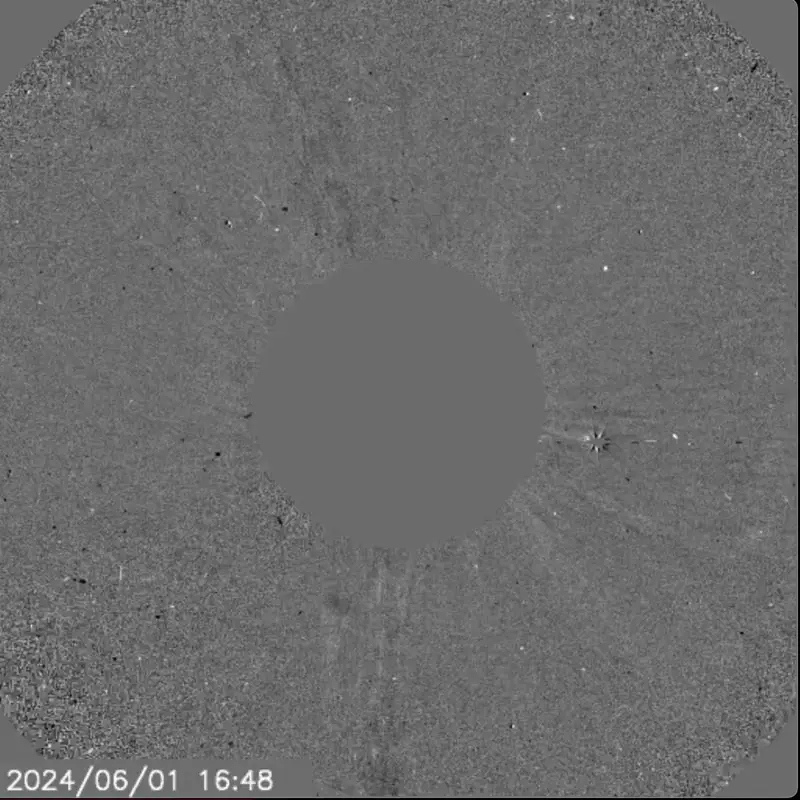
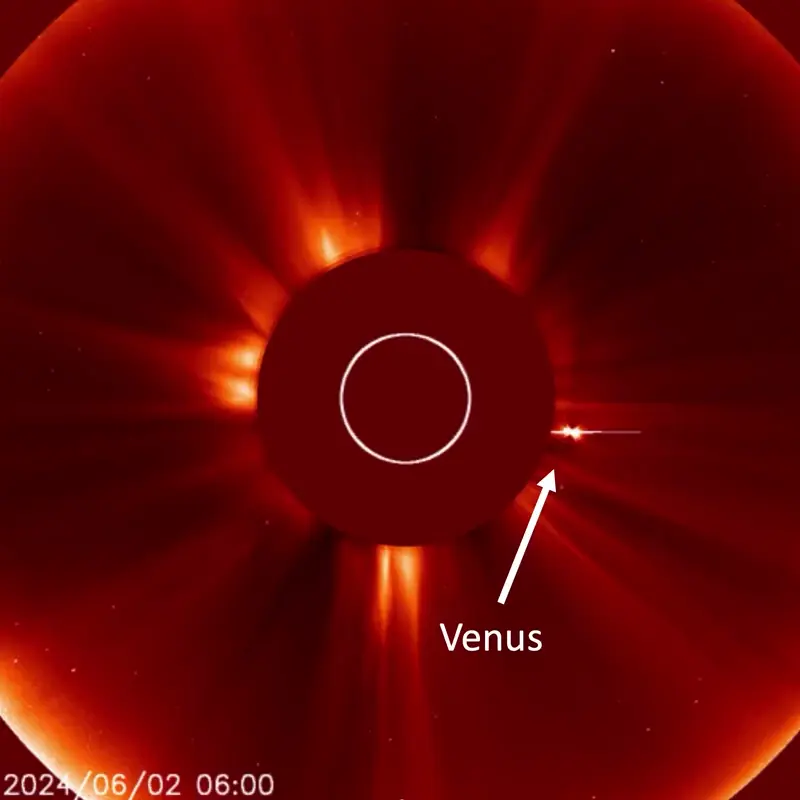
Sun news for June 2, 2024: BAM! Another X flare
In the last 24 hours, the now-famous sunspot region AR3697 released another X flare. This X1.0 flare happened at 18:24 UTC on June 1. It caused an R3 (strong) radio blackout over the Americas. There was no significant coronal mass ejection (CME) observed with the X flare. But a lesser flare – an M7.4 flare around 19:01 UTC yesterday – did send something our way. Notice that this M flare came less than an hour after the X! AR3697 just keeps on ticking! Analysis is ongoing, but current estimates are for an Earth-directed CME and geomagnetic activity on June 3-4. Initial indications are for a G1 (minor)-G3 (strong) geomagnetic storm. That would mean auroral displays for higher latitudes at a minimum. We await confirmation of the forecast from NOAA’s Space Weather Prediction Center later today. Stay tuned.
Last 24 hours: Solar activity has remained high during the past day, thanks to AR3697’s X flare. During our observation period between 11 UTC yesterday to 11 UTC today, there were 23 flares: one X, four M flares, and 18 Cs. The largest was an X1.0 flare by AR3697 in the southeast at 18:24 UTC on June 1. This is the breakdown of the X and M flares:
– X1.0 by AR3697 at 18:24 UTC on June 1. R3 (strong) radio blackout over North America.
– M4.4 by AR3697 at 19:00 UTC on June 1. R1 (minor) radio blackout over the Americas.
– M7.4 by AR3697 at 19:01 UTC on June 1. R2 (moderate) radio blackout over the Americas.
– M1.2 by AR3697 at 04:41 UTC on June 2. R1 (minor) radio blackout over Asia.
– M2.0 by AR3697 at 08:40 UTC on June 2. R1 (minor) radio blackout over the Middle East.
The lead flare producer and producer of the largest flares was active region AR3697, which produced the X flare, four M flares, and 14 C flares. AR3697 maintained its beta-gamma-delta magnetic configuration, meaning it has the potential for more M and X flares. The sun currently has eight labeled sunspot regions on its Earth-facing side. Newcomers were numbered AR3700 and AR3701.
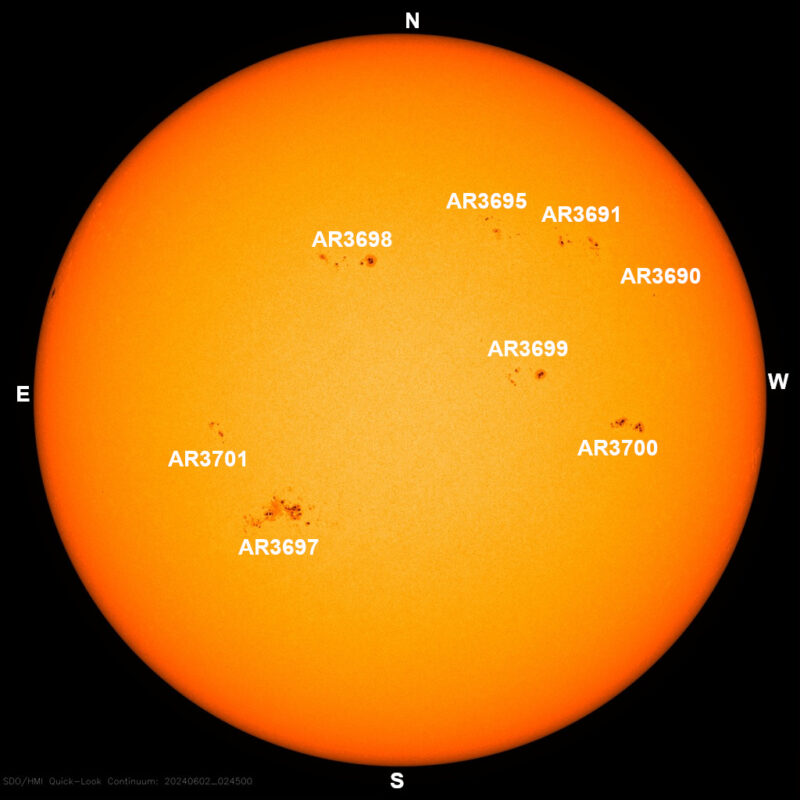
Sun news for June 1, 2024: Two X flares!
Giant active region AR3697 released two X flares during our observation period. First, the sun produced an X1.1 flare at about 22 UTC (5 p.m. Central) on May 31. An R3 (strong) radio blackout followed the blast, affecting an area over Hawaii. The second X flare was an X1.4 at 8:48 UTC on June 1. The blast caused an R3 (strong) radio blackout over Oman in the Arabian Peninsula. Not surprisingly, AR3697 was the lead flare producer of the day with two X flares, one M and six C flares. This giant sunspot region AR3697 (formerly AR3664, producer of the biggest flare of Solar Cycle 25 so far, an X8.8 on May 14) is now close to a geoeffective position. And that means any coronal mass ejections (CMEs) it produces have a better chance of affecting Earth’s magnetic field and possibly causing auroral displays. There are already auroral displays expected this weekend. The fastest CMEs can reach Earth in around 15 hours. Will a fast one come our way and give us a fantastic auroral display Saturday night? We await word from space weather forecasters about any coronal mass ejection produced during this event. Stay tuned.
Last 24 hours: Solar activity was high during the past day, thanks to AR3697’s two X flares. During our observation period between 11 UTC yesterday to 11 UTC today, there were 19 flares: two Xs, an M flare, and 16 Cs. The largest was an X1.4 flare by AR3697 in the southeast at 8:48 UTC on June 1. This is the breakdown of the X and M flares:
-M1.1 by AR3697 at 11:20 UTC on May 31. R1 (minor) radio blackout over Libya.
-X1.1 by AR3697 at 22 UTC on May 31. R3 (strong) radio blackout over Hawaii.
-X1.4 by AR3697 at 8:48 UTC on June 1. R3 (strong) radio blackout over Oman.
The lead flare producer and producer of the largest flares was active region AR3697, which produced the two X flares of the period, an M flare, and six C flares. In addition, AR3691 (former AR3663) produced six small C flares. Both regions AR3697 and AR3691 maintain their beta-gamma magnetic configuration, meaning they have the potential for more M and X flares. The sun currently bears seven labeled sunspot regions on its Earth-facing side. A newcomer was numbered AR3599.
